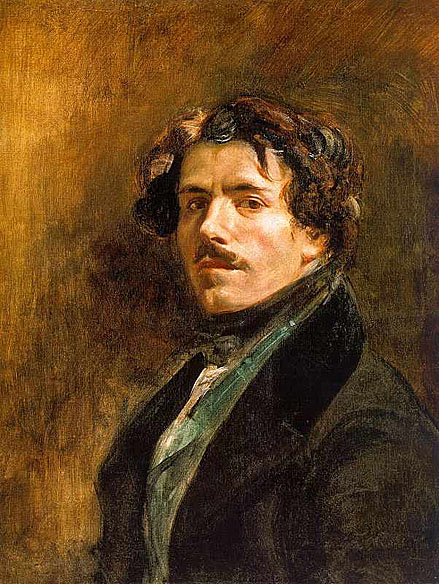
French Romantic Painter
1798 - 1867

Ferdinand Victor Eugène Delacroix was one of the most important of the French Romantic painters. Delacroix's use of expressive brushstrokes and his study of the optical effects of color profoundly shaped the work of the Impressionists, while his passion for the exotic inspired the artists of the Symbolist movement. A fine lithographer, Delacroix illustrated various works of William Shakespeare, the Scottish writer Sir Walter Scott, and the German writer Johann Wolfgang von Goethe.
In contrast to the Neoclassical perfectionism of his chief rival Ingres, Delacroix took for his inspiration the art of Rubens and painters of the Venetian Renaissance, with an attendant emphasis on color and movement rather than clarity of outline and carefully modeled form. Dramatic and romantic content characterized the central themes of his maturity, and led him not to the classical models of Greek and Roman art, but to travel in North Africa, in search of the exotic. Friend and spiritual heir to Théodore Géricault, Delacroix was also inspired by Byron, with whom he shared a strong identification with the "forces of the sublime", of nature in often violent action.
However, Delacroix was given neither to sentimentality nor bombast, and his Romanticism was that of an individualist. In the words of Baudelaire, "Delacroix was passionately in love with passion, but coldly determined to express passion as clearly as possible."
Delacroix was born at Charenton (Saint-Maurice), Val de Marne département, in the Île de France région near Paris, France.
There is reason to believe that his father, Charles Delacroix, was infertile at the time of Eugène's conception and that his real father was Talleyrand, who was a friend of the family and successor of C. Delacroix as minister of the foreign affairs, and whom the adult Eugène resembled in appearance and character. Throughout his career as a painter, he was protected by Talleyrand, who served successively the Restoration and King Louis-Philippe, and ultimately as ambassador of France in Great Britain, and later by Talleyrand's grandson, Duke of Morny, half-brother of Napoleon III and speaker of the French House of Commons.
His early education was at the Lycée Louis-le-Grand, where he steeped himself in the classics and won awards for drawing. In 1815 he began his training with Pierre-Narcisse Guérin in the neoclassical style of Jacques-Louis David. An early church commission, The Virgin of the Harvest, (1819), displays a Raphaelesque influence, but another such commission, The Virgin of the Sacred Heart, (1821), evidences a freer interpretation. It precedes the influence of the more colorful and rich style of the Flemish painter Peter Paul Rubens (1577-1640), and fellow French artist Théodore Géricault (1791-1824), whose works marked an introduction to Romanticism in art.
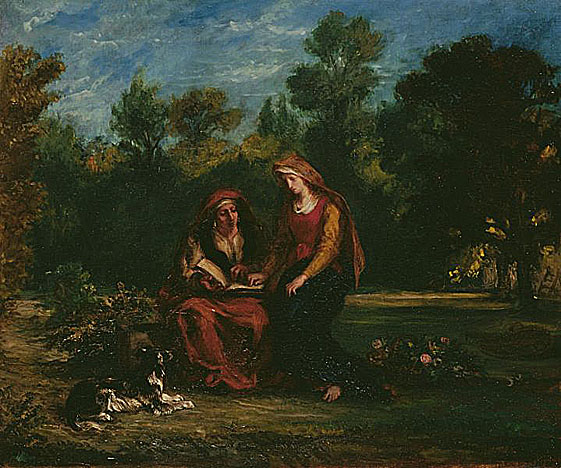
The impact of Géricault's Raft of the Medusa was profound, and stimulated Delacroix to produce his first major painting, The Barque of Dante, which was accepted by the Paris Salon in 1822. The work caused a sensation, and was largely derided by the public and officialdom, yet was purchased by the State for the Luxembourg Galleries; the pattern of widespread opposition to his work, countered by a vigorous, enlightened support, would continue throughout his life. Two years later he again achieved popular success for his Massacre at Chios.
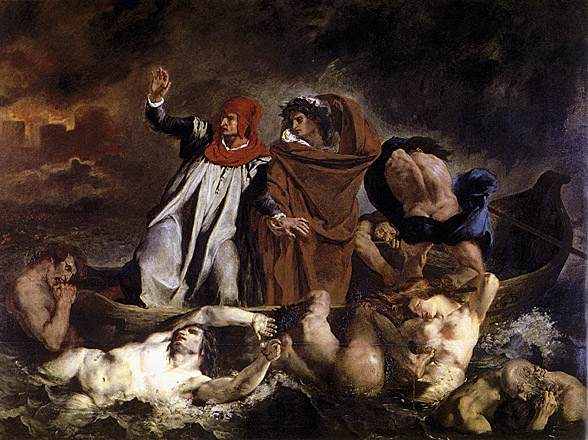
The time of classical painters imitating Greek and Roman art was over: they no longer had a place in current tastes. The underlying idea behind The Barque of Dante is that great geniuses from other lands have written works suffused with a way of seeing and feeling quite different from that of the French. Reading them stimulates the mind through new subject matter and the imagination through new boldness. So new, in fact, that Delacroix's painting was not without its critics: "a real daub" was how Delécluze, a disciple of David, described it. Delacroix drew on the visionary writing of the Italian poet in order to create a painting of definite force and romanticism.
Although inspired by the mythological tradition, the subject of the work is the Italian poet Dante Alighieri (1265-1321). In the Divine Comedy (1306-21), Dante recounts his poetic visit to Hell, guided by Virgil. The Divine Comedy is divided into three parts: Hell, Purgatory, and Paradise. Dante's voyage begins in Hell in the company of the Roman poet, passing through nine successive circles on his way to meet Beatrice, who will guide him through Paradise. In this scene, Dante and Virgil, piloted by Phlegyas, cross the lake surrounding the infernal city of Dis; the souls of the damned writhe in the water, trying to escape their fate by hanging onto the boat.
Delacroix's painting of the Massacre at Chios (also called Massacre at Scio, French: Scènes des massacres de Scio), shows sick, dying Greek civilians about to be slaughtered by the Turks. One of several paintings he made of this contemporary event, it expresses sympathy for the Greek cause in their War of Independence against the Turks, a popular sentiment at the time for the French people. Delacroix was quickly recognized as a leading painter in the new Romantic style, and the picture was bought by the state. His depiction of suffering was controversial however, as there was no glorious event taking place, no patriots raising their swords in valor as in David's Oath of the Horatii, only a disaster. Many critics deplored the painting's despairing tone; the artist Antoine-Jean Gros called it "a massacre of art". The pathos in the depiction of an infant clutching its dead mother's breast had an especially powerful effect, although this detail was condemned as unfit for art by Delacroix's critics. A viewing of the paintings of John Constable prompted Delacroix to make extensive, freely painted changes to the sky and distant landscape.
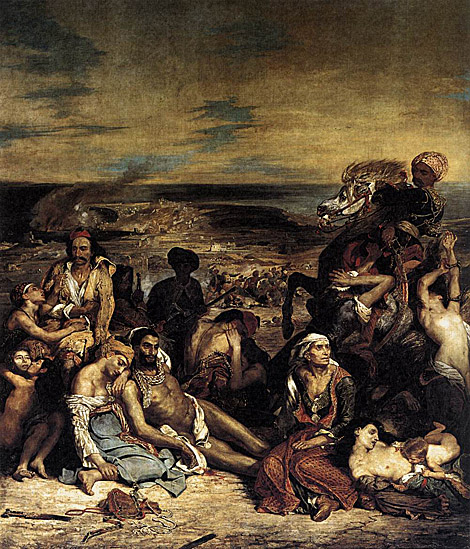
Horrified by the massacres perpetrated in Greece by the Sublime Porte, Delacroix denounced this crime against humanity - this genocide. His denunciation took immediate form in The Massacre of Chios; his gesture parallels that of his fervent admirer, Picasso, in his representation of the massacre at Guernica. Delacroix depicted a landscape racked with fire, stretching desolately behind a group of prisoners awaiting execution. The Massacre is all but a manifesto in its liberated expression of light and atmosphere through color; after it, 19th century painting could never be the same again.
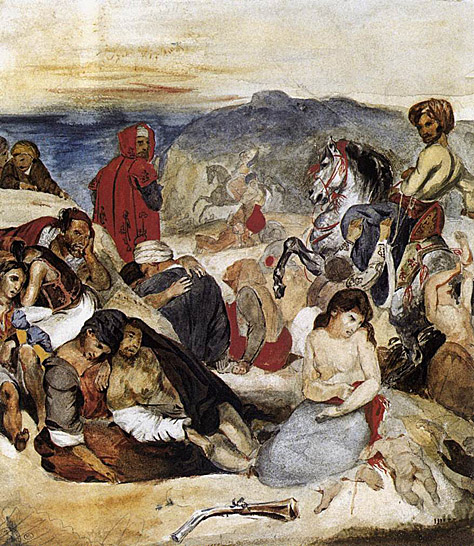
Delacroix produced a second painting in support of the Greeks in their war for independence, this time referring to the capture of Missolonghi by Turkish forces in 1825. With a restraint of palette appropriate to the allegory, Greece Expiring on the Ruins of Missolonghi displays a woman in Greek costume with her breast bared, arms half-raised in an imploring gesture before the horrible scene: the suicide of the Greeks, who chose to kill themselves and destroy their city rather than surrender to the Turks. A hand is seen at the bottom, the body having being crushed by rubble. The whole picture serves as a monument to the people of Missolonghi and to the idea of freedom against tyrannical rule. This event interested Delacroix not only for his sympathies with the Greeks, but also because the poet Byron, whom Delacroix greatly admired, had died there.

A trip to England in 1825 included visits to Thomas Lawrence and Richard Bonington, and the color and handling of English painting provided impetus for his only full-length portrait, the elegant Portrait of Louis-Auguste Schwiter, (1826-30). At roughly the same time, Delacroix was creating romantic works of numerous themes, many of which would continue to interest him for over thirty years. By 1825 he was producing lithographs illustrating Shakespeare, and soon thereafter lithographs and paintings from Goethe's Faust. Paintings such as The Combat of the Giaour and Hassan, (1826), and Woman with Parrot, (1827), introduced subjects of violence and sensuality which would prove to be recurrent.
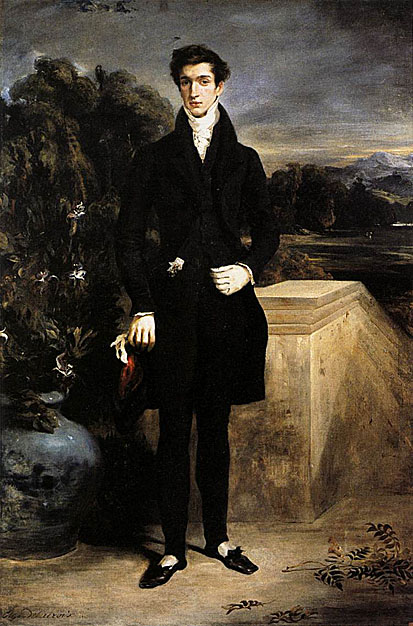
As Byron signifies Romantic poetry, so Romantic French art means above all Delacroix. Like Byron he achieved his flamboyant artistic effects through intense intellectual application and a firm grasp of technique. Pupil of an academic artist, he was essentially self-taught through the study of the great Renaissance and seventeenth-century colorists in the Louvre. He was fascinated by the vibrant brushwork of the Venetians and their Flemish heir Rubens, imitating their capacity to simulate brilliant daylight even in the shadows, their use of color instead of line as the primary structural element. It was precisely these effects which, as employed by Constable in the Hay-Wain exhibited at the Paris Salon in 1824, caused a sensation and further exacerbated Delacroix's fashionable Anglomania. In 1825, having sold his picture of the Massacre of Chios to the French State, he set out for London with two English friends, the watercolorists Richard Bonington and Thales Fielding. They visited galleries and the theatre and read English poets. Delacroix met other English artists, including Thomas Lawrence. Appropriately for a painting in an English collection, the lifesize likeness of Louis-Auguste Schwiter, painted after Delacroix's return to Paris, is an essay in the portrait style of Lawrence.
Schwiter, a lifelong friend of Delacroix, was himself a painter. He is presented here, however, as a gentleman, dressed in elegant black and hat in hand, standing on what appears to be the terrace of a great country house, as if waiting to be admitted. The blue Chinese vase with its heavily paint-textured flowers contrasts with the red lining of his hat. Like the trumpet vine clippings on the paving, these touches of color serve to relate the foreground to the brooding sunset landscape (said to have been painted in part by Paul Huet, another artist friend), thus counteracting the isolation of Schwiter's monochrome silhouette.
The portrait is lit from the right, a reversal of the more usual illumination from the left, highlighting the left side of the sitter's face and perhaps helping to account for the curiously tentative impression he gives, despite his firm stance in the centre of the picture and his direct gaze. The un-emphatic 'modern' pose, with its hint of English-style reserve, and the free 'unfinished' brushwork made this full-length portrait, at once so formal and so unconventional, unacceptable to the judges of the 1827 Paris Salon exhibition, and it was rejected. Delacroix later reworked the painting, finally completing it in 1830.
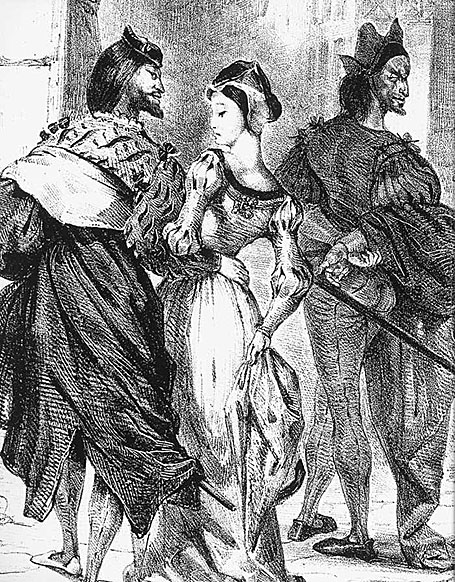
Predictably, the critics censored what they saw as technical eccentricity - Delacroix's almost completely inked plates and slashing use of the scraper. In their view, his forms and figures lacked purity and his poses were excessively contorted. But Goethe himself was delighted. Eckermann recorded his judgment: "'It must be admitted,' said Goethe, 'that I myself scarcely imagined the scene so perfectly! M. Delacroix is a great artist of exceptional talent, who has found in Faust precisely the subject that suits him. The French criticize his impulsive style; but here it is just what is required. He will - at least, I hope he will - illustrate the whole of Faust, and I look forward to the pleasure of seeing it, particularly the witches' kitchen and the Brocken scenes. Clearly Delacroix has a profound knowledge of life; in such matters a city like Paris is the perfect teacher.'"
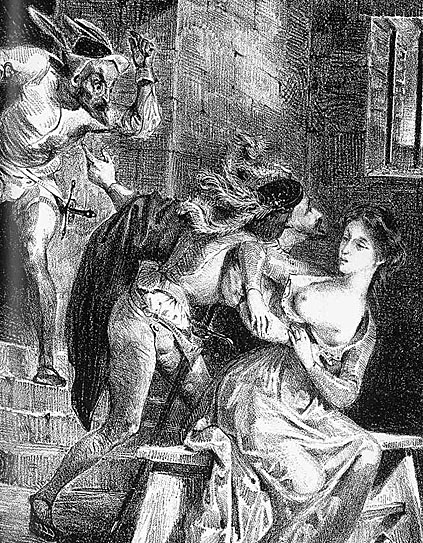
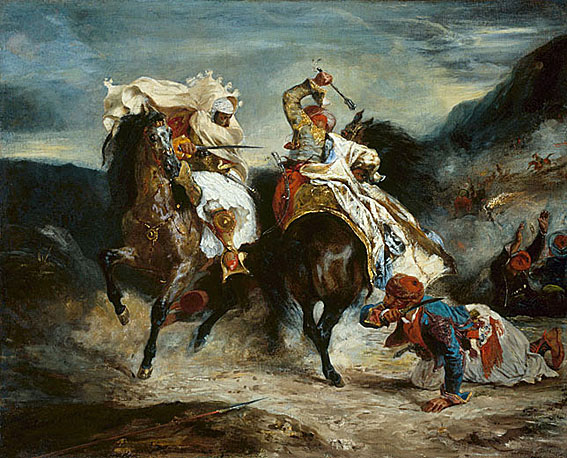
Hassan's curse of the Hero
Pieced together, the fragments of Byron's "Turkish tale" yield a story that combines doomed love with the clash of civilizations. A "Giaour" in the eyes of his antagonist ("Giaour," Byron explains in a note, means "Infidel"), the Christian hero of this poem goes to battle with the Muslim Hassan. His aim is to avenge the memory of Leila, the slave girl whom Hassan has had drowned after learning that she had been unfaithful to him with his enemy. In a manner that marks Byron's immersion in Gothic romances such as The Italian, the poem concludes with its hero's impenitent confession to the monks among whom he has chosen to end his life-a confession in which, however, the crimes remain "unspeakable."
The excerpt that follows, which relates the dying Hassan's curse of the Giaour, also represents a decisive moment in the early literary history of the vampire: a traditional figure in the oral folk culture of Europe's eastern margins, whom Byron here helps to introduce into the print culture of the modern West.
But thou, false Infidel! shalt writhe
Beneath avenging Monkir's scythe;
And from its torment 'scape alone
To wander round lost Eblis' throne;
And fire unquench'd, unquenchable
Around-within-thy heart shall dwell,
Nor ear can hear, nor tongue can tell
The tortures of that inward hell!
But first, on earth, as Vampire sent,
Thy corse shall from its tomb be rent;
Then ghastly haunt thy native place,
And suck the blood of all thy race,
There from thy daughter, sister, wife,
At midnight drain the stream of life;
Yet loathe the banquet which perforce
Must feed thy livid living corse;
Thy victims ere they yet expire
Shall know their daemon for their sire,
As cursing thee, thou cursing them,
Thy flowers are wither'd on the stem.
But one that for thy crime must fall
The youngest-most belov'd of all,
Shall bless thee with a father's name
That word shall wrap thy heart in flame!
Yet must thou end thy task, and mark
Her cheek's last tinge, her eye's last spark,
And the last glassy glance must view
Which freezes o'er its lifeless blue;
Then with unhallowed hand shalt tear
The tresses of her yellow hair,
Of which in life a lock when shorn,
Affection's fondest pledge was worn;
But now is borne away by thee,
Memorial of thine agony!
Wet with thine own best blood shall drip,
Thy gnashing tooth and haggard lip;
Then stalking to thy sullen grave
Go-and with Gouls and Afrits rave;
Till these in horror shrink away
From spectre more accursed than they!
From The Giaour: A Fragment of a Turkish Tale (1813)
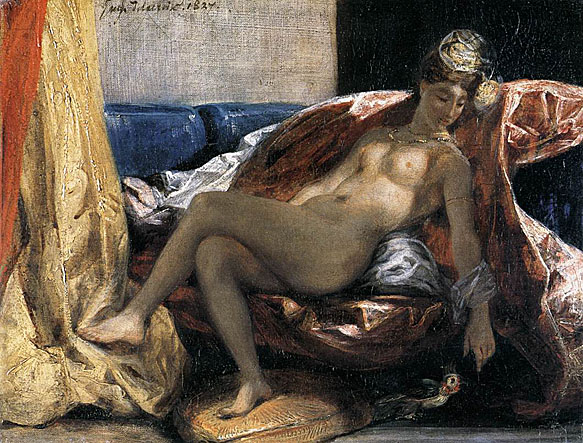
These various romantic strands came together in the Death of Sardanapalus, (1827-28). Delacroix's painting of the death of the Assyrian king Sardanapalus shows an emotionally stirring scene alive with beautiful colors, exotic costumes and tragic events. The Death of Sardanapalus depicts the besieged king watching impassively as guards carry out his orders to kill his servants, concubines and animals. The literary source is a play by Byron, although the play does not specifically mention any massacre of concubines.
Sardanapalus' attitude of calm detachment is a familiar pose in Romantic imagery in this period in Europe. The painting, which was not exhibited again for many years afterward, has been regarded by some critics as a gruesome fantasy involving death and lust. Especially shocking is the struggle of a nude woman whose throat is about to be cut, a scene placed prominently in the foreground for maximum impact. However, the sensuous beauty and exotic colors of the composition make the picture appear pleasing and shocking at the same time.
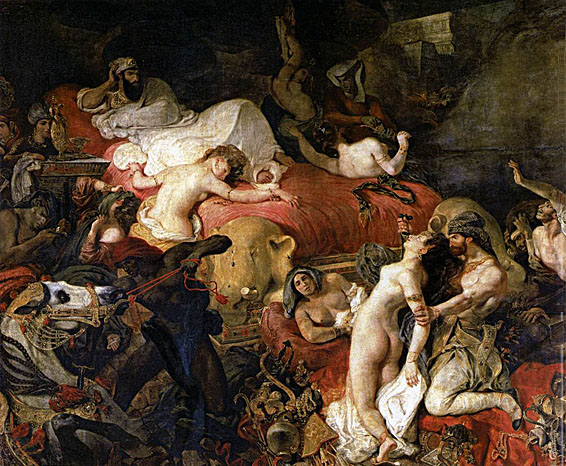
The diagonal rhythms, the fluidity of line, the brilliance of the colours and its profound sensuality make The Death of Sardanapalus a masterpiece of 19th-century art.
By George Gordon, Lord Byron
A variety of Romantic interests were again synthesized in The Murder of the Bishop of Liège, (1829). It also borrowed from a literary source, this time Scott, and depicts a scene from the Middle Ages, that of the murder of Louis de Bourbon, Bishop of Liège amidst an orgy sponsored by his captor, William de la Marck. Set in an immense vaulted interior which Delacroix based on sketches of the Palais de Justice in Rouen and Westminster Hall, the drama plays out in chiaroscuro, organized around a brilliantly lit stretch of tablecloth. In 1855 a critic described the painting's vibrant handling as "Less finished than a painting, more finished than a sketch, The Murder of the Bishop of Liège was left by the painter at that supreme moment when one more stroke of the brush would have ruined everything".
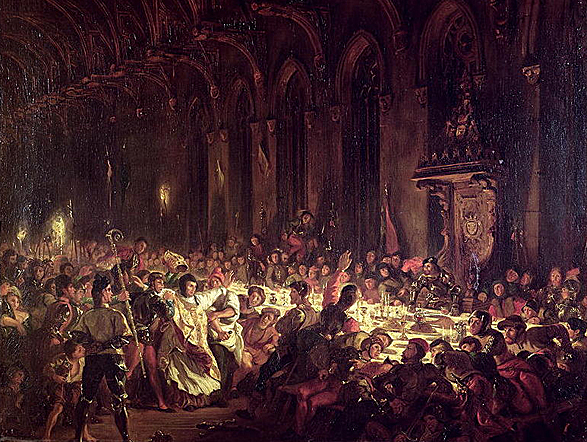
Senex Magister
Quentin Durward
Quentin Durward is a historical novel by Walter Scott, first published in 1823 "In Three Volumes". The story concerns a Scottish archer in the service of the French King Louis XI. This romantic novel displays life as a Scottish mercenary under Louis XI of France. It follows a young Scot who fled his homeland, and searching for meaning in life, finds it at the court of Louis XI. The novel is backed by much historical fact and gives very accurate portrayal of historical figures such as the Duke of Burgundy and Cardinal Balue. Although the storyline is somewhat cliché, the novel is worth reading for anyone who has an interest in Medieval history or Scottish and French culture.
The plot centers on the rivalry between Louis XI of France and Charles the Bold, Duke of Burgundy. Louis incites the citizens of Liège to revolt against Charles, and, under the command of Louis's ally, William De La Marck, they seize and murder Charles's brother-in-law, Louis de Bourbon, Bishop of Liège. At the time of the murder Louis is at Charles's camp at Peronne, hoping to fool him with a false display of friendship. Charles, though, sees through his pretence, accuses him of instigating the uprising, and has him imprisoned. Louis's superior coolness of mind permits him to allay Charles's suspicions and to regain his liberty. In a sub-plot, the Burgundian heiress Isabelle de Croye takes refuge at Louis's court when Charles attempts to give her hand in marriage to his odious favorite Campo-Basso. Louis, in turn, resolves to give her in marriage to de la Marck, and sends her to Flanders under the pretense of placing her under the protection of the Bishop of Liège. She is guarded on her journey by Quentin Durward, an archer, who has left behind poverty in Scotland to join Louis' Scottish Guard. Quentin prevents the intended treachery and earns Isabelle's love. Charles, though, promises her in marriage to the Duke of Orleans (heir to the French crown) but she refuses, and, in anger, the Duke promises her to whoever brings him the head of De La Marck. This Quentin does with the help of his uncle, Ludovic Lesley, and wins Isabelle's hand.
Delacroix's most influential work came in 1830 with the painting Liberty Leading the People, which for choice of subject and technique highlights the differences between the romantic approach and the neoclassical style. Probably Delacroix's best known painting, it is an unforgettable image of Parisians, having taken up arms, marching forward under the banner of the tricolor representing liberty and freedom; Delacroix was inspired by contemporary events to invoke the romantic image of the spirit of liberty. The soldiers lying dead in the foreground offer poignant counterpoint to the symbolic female figure, who is illuminated triumphantly, as if in a spotlight.
The French government bought the painting but officials deemed its glorification of liberty too inflammatory and removed it from public view. Nonetheless, Delacroix still received many government commissions for murals and ceiling paintings. He seems to have been trying to represent the spirit and the character of the people, rather than glorify the actual event, a revolution against King Charles X which did little other than bring in a different king, Louis-Philippe, to power.
Following the Revolution of 1848 that saw the end of the reign of King Louis Philippe, Delacroix' painting, Liberty Leading the People, was finally put on display by the newly elected President, Louis Napoleon (Napoleon III.) Today, it is visible in the Louvre museum.
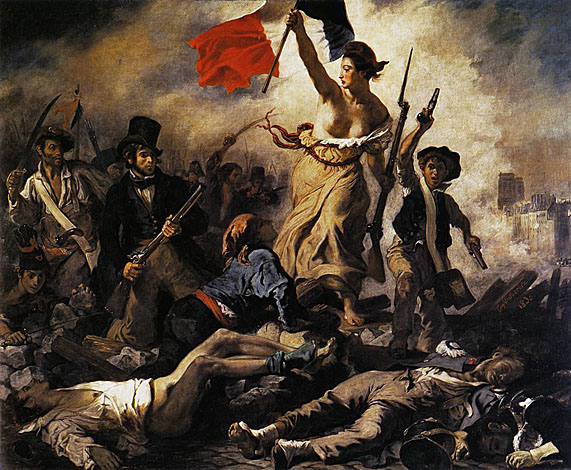
In 1832, he traveled to Spain and North Africa, as part of a diplomatic mission to Morocco shortly after the French conquered Algeria. He went not primarily to study art, but to escape from the civilization of Paris, in hopes of seeing a more primitive culture. He eventually produced over 100 paintings and drawings of scenes from or based on the life of the people of North Africa, and added a new and personal chapter to the interest in Orientalism. Delacroix was entranced by the people and the costumes, and the trip would inform the subject matter of a great many of his future paintings. He believed that the North Africans, in their attire and their attitudes, provided a visual equivalent to the people of Classical Rome and Greece.
He managed to sketch some women secretly in Algiers, as in the painting Women of Algiers in their Apartment (1834), but generally he encountered difficulty in finding Moslem women to pose for him because of Muslim rules requiring that women be covered. Less problematical was the painting of Jewish women in North Africa, as subjects for the Jewish Wedding in Morocco (1837-41).
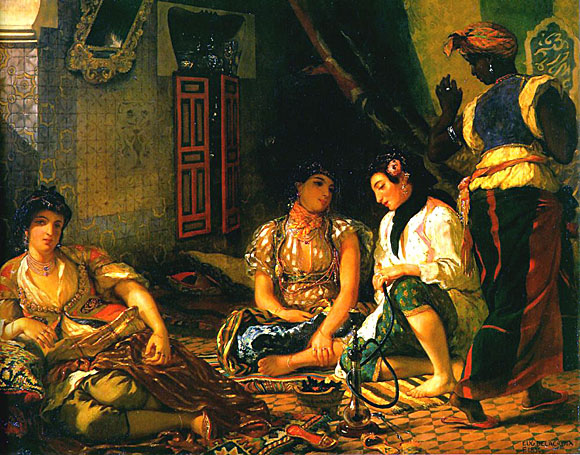
During his visit to this country, Delacroix witnessed spectacles belonging to a noble and primitive way of life which provided material for his art until he died; but he had not been allowed to enter the jealously guarded harems of the Moslems. It was the chief harbor engineer at Algiers who persuaded one of the port officials, a former reis or owner of privateers, to allow Delacroix into his own harem.
In these few hours Delacroix did several watercolor sketches, some of which are in the Louvre. Using them as a basis, he painted a large picture on his return, and exhibited it in the 1834 salon. He wanted to show the dark tones of flesh and the subdued colors in the warm half-light of the harem.
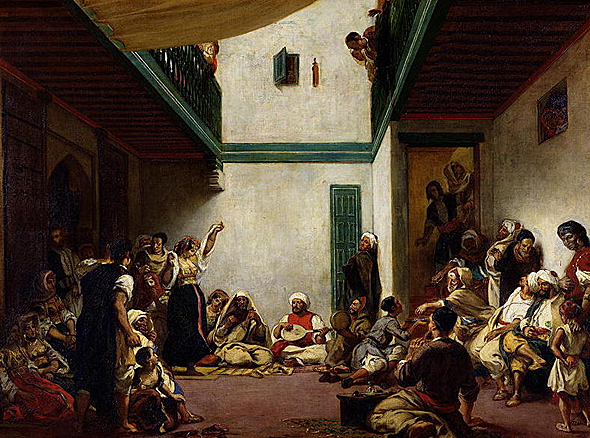
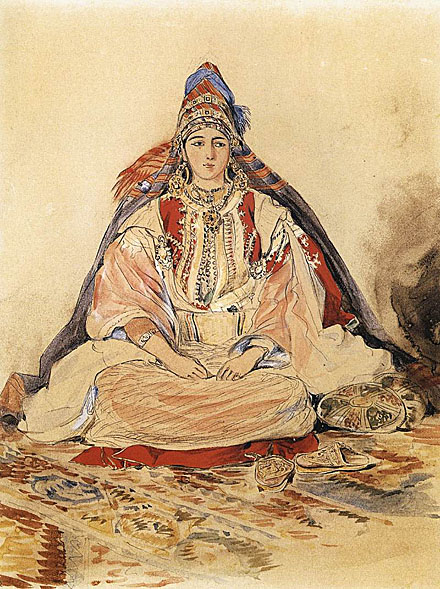
While in Tangier he made many sketches of the people and the city, subjects to which he would return until the end of his life. Animals--the embodiment of romantic passion-- were incorporated into paintings such as Arab Horses Fighting in a Stable (1860), The Lion Hunt (of which there exists many versions, painted between 1856 and 1861), and Arab Saddling his Horse (1855).
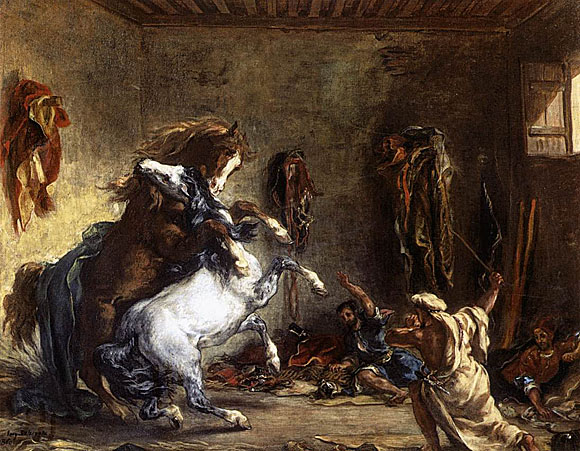
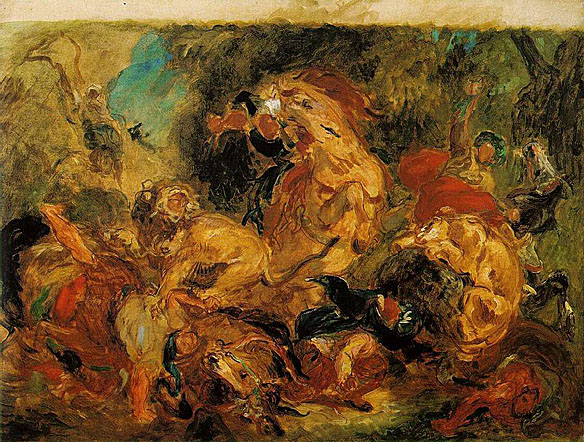
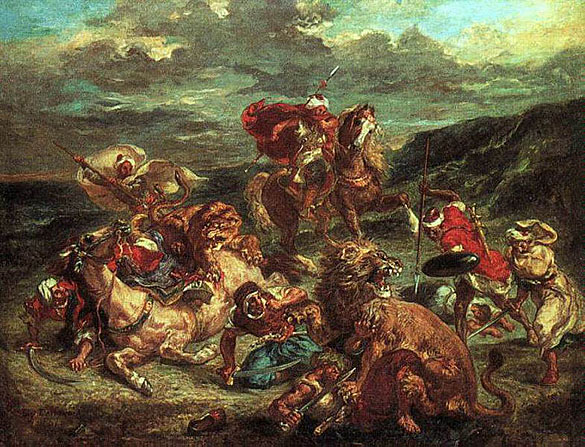
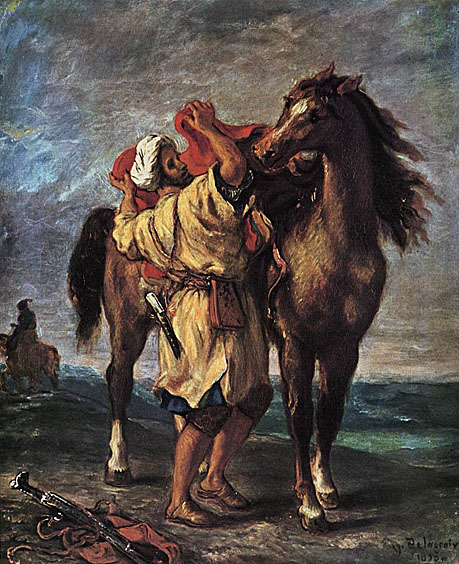
In 1838 Delacroix exhibited Medea about to Kill Her Children, which created a sensation at the Salon. His first large-scale treatment of a scene from Greek mythology, the painting depicts Medea clutching her children, dagger drawn to slay them in vengeance for her abandonment by Jason. The three nude figures form an animated pyramid, bathed in a raking light which penetrates the grotto in which Medea has hidden. Though the painting was quickly purchased by the State, Delacroix was disappointed when it was sent to the Lille Museé des Beaux-Arts; he had intended for it to hang at the Luxembourg, where it would have joined The Barque of Dante and Scenes from the Massacres of Chios.
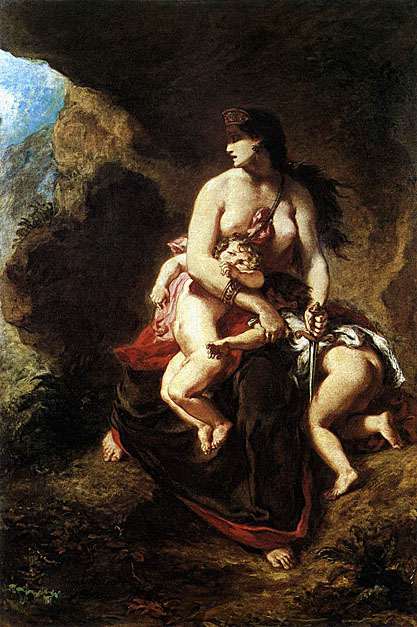
From 1833 Delacroix received numerous commissions to decorate public buildings in Paris. In that year he began work for the Salon du Roi in the Chambre des Députés, Palais Bourbon, which was not completed until 1837. For the next ten years he painted in both the Library at the Palais Bourbon and the Library at the Palais du Luxembourg. In 1843 he decorated the Church of St. Denis du Saint Sacrement with a large Pietà, and from 1848 to 1850 he painted the ceiling in the Galerie d'Apollon of the Louvre. From 1857 to 1861 he worked in the Chapelle des Agnes at St. Sulpice. These commissions offered him the opportunity to compose on a large scale in an architectural setting, much as had those masters he admired, Paolo Veronese, Tintoretto, and Rubens.
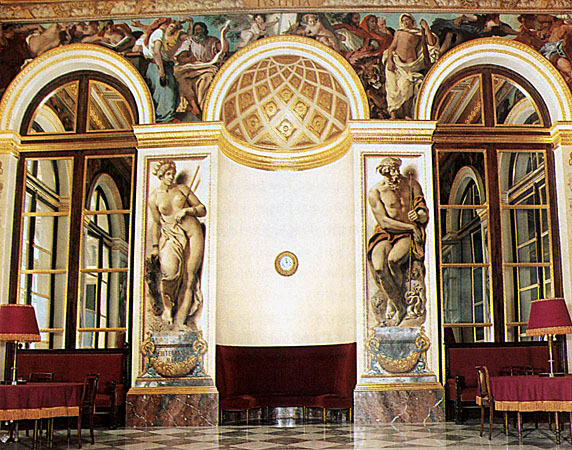
Like Michelangelo when he began the decoration of the Sistine Chapel, Delacroix knew nothing about the technique of fresco. So before executing the first commission, Delacroix spent several weeks with his family in the abbaye de Valmont, in Normandy, experimenting with fresco. These experiments enabled him to invent his own technique. Aware of the limitations of distemper, and noting that fresco did not easily adapt to the climate, he decided to paint the walls of the Salon du Roi with oil, to which he added a little colorless wax or encaustic. This allowed him to imitate the mat surface of fresco and protect the colors from the effects of damp; it also made it possible to retouch his work, which the use of distemper would have ruled out. This was the technique that he used for all subsequent decorations.
Throughout 1837, Delacroix worked alone on the Salon du Roi, accepting assistance only for certain ornaments, and in 1838, the public could finally admire the finished work. It comprised four large sections of a coffered ceiling each decorated with a large allegorical figure in classical dress: Justice, Agriculture, Industry and War. In addition, there were four little coffers representing Putti bearing emblems. On the pilasters, he personified the rivers of France and the seas or oceans that they flow into, such as The Garonne and The Mediterranean. A frieze running round the upper wall above the windows and doors echoes these themes, contrasting the evils of war with the virtues of justice, industry and agriculture.
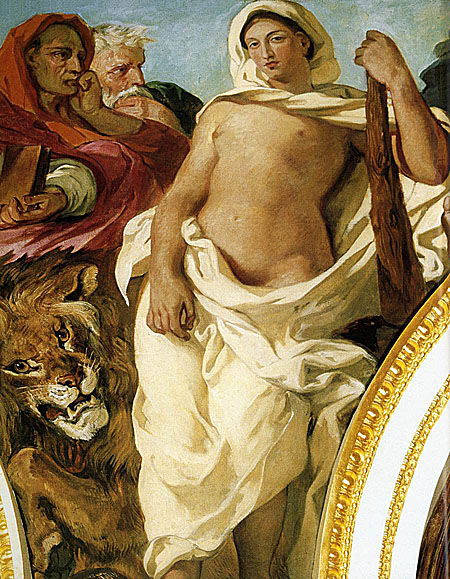
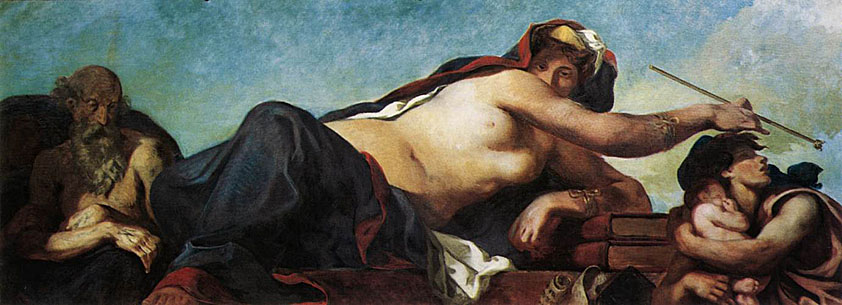
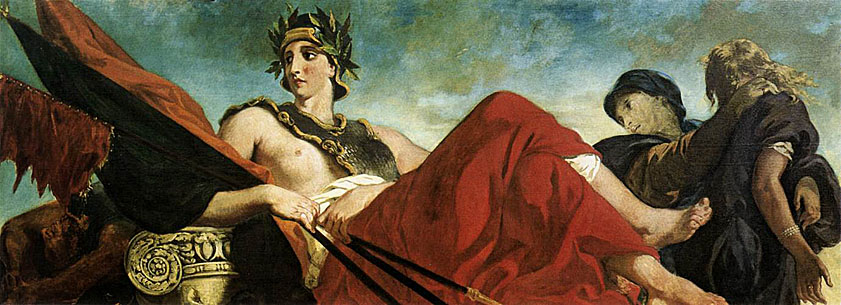

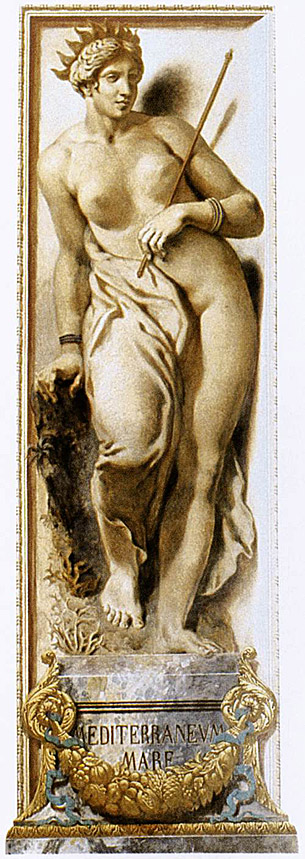
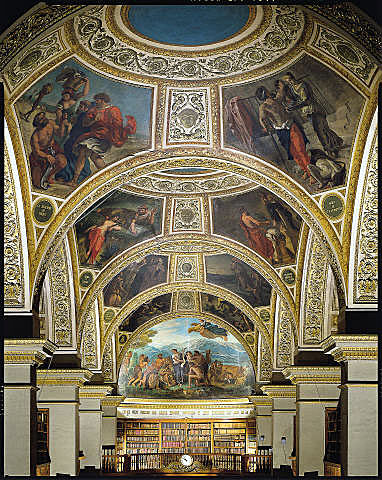
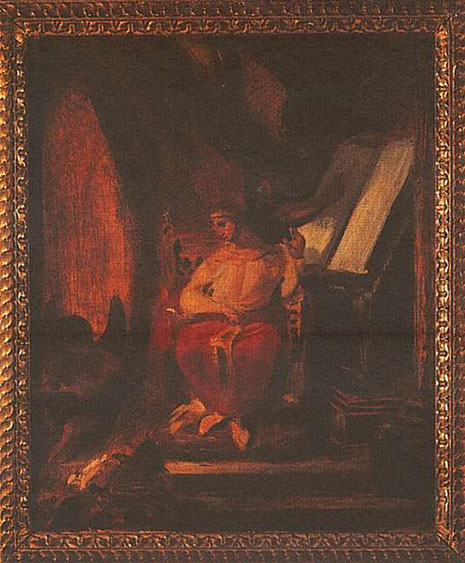
Senex Magister

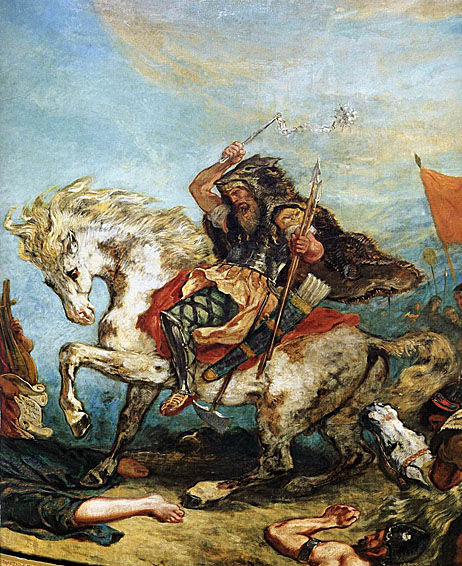
IGNORANCE IS THE CAUSE OF FEAR
That is the meaning of Atilla or anyone who wishes to destroy knowkedge for the sake of political power.
Senex Magister
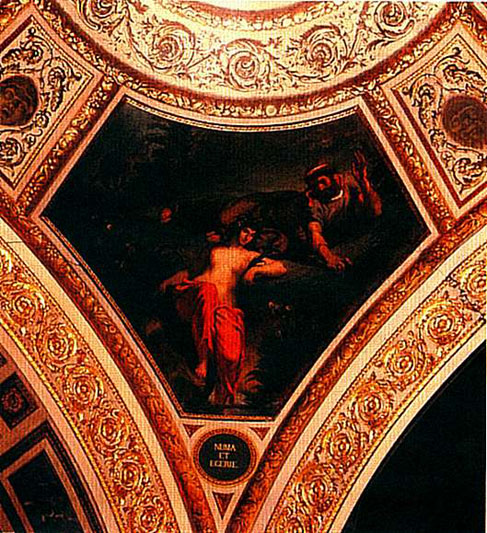
Egeria was later categorized by the Romans as one of the Camenae, minor deities who came to be equated with the Greek Muses as Rome fell under the cultural hegemony of Greece; so Dionysius of Halicarnassus listed Egeria among the Muses.
A grove sacred to Egeria in connection with Numa stood close by a busy gate of Rome, the Porta Capena. In the second century, when Herodes Atticus recast an inherited villa nearby as a great landscaped estate, the natural grotto was formalized as an arched interior with an apsidal end where a statue of Egeria once stood in a niche; the surfaces were enriched with revetments of green and white marble facings and green porphyry flooring and friezes of mosaic. The primeval spring, one of dozens of springs that flow into the river Almone, was made to feed large pools one of which was known as Lacus Salutaris the "Lake of Health". (Juvenal, Satire III.17-20) regretted an earlier phase of architectural elaboration:
Nymph of the Spring! More honour'd hadst thou been,
If, free from art, an edge of living green,
Thy bubbling fount had circumscribed alone,
And marble ne'er profaned the native stone. (Translated by William Gifford)
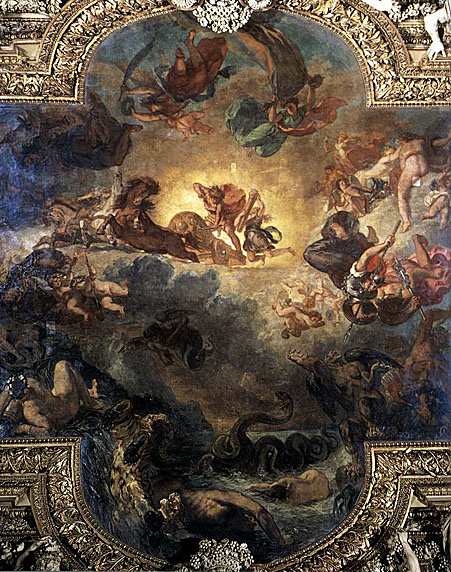
Delacroix's greatest virtuosity was reserved for a project which came in 1850, between the decoration of the Senate and Palais Bourbon libraries and the monumental Salon de la Paix at the Hotel de Ville, and was the most important commission of Delacroix's life. It was nothing less than the decoration of the Galerie d'Apollon in the Louvre. Following a fire, Le Vau had reconstructed this historical gallery for Louis XIV, while the decoration was entrusted to Charles Le Brun. Then in 1678, Louis left Paris for Versailles, and work ceased. In 1793, in the wake of the French Revolution, the Louvre became a museum, and the Second Republic deemed the completion of the decoration a republican duty.
Le Brun had intended a subject dear to the heart of the Sun King: Apollo on his chariot. For Delacroix, to make his mark at the very heart of the Louvre and to do so not by exhibiting paintings but by decorating the central part of a ceiling was a thrilling opportunity. Before he began, he felt the need to study the works of Rubens in Belgium.
In his Apollo Slays Python, Delacroix retained Le Brun's ambition to portray the mythological figure of Apollo in the gallery of that name. But Delacroix enhanced Le Brun's allegory with a further allegory close to his own heart: intelligence wrestling with barbarity and light struggling with darkness. By emphasizing the contrast between the two parts of his composition, the world of the sun above and that of darkness beneath, Delacroix transformed Le Brun's project and raised it to the plane of an eternal symbol.
The subject, which Delacroix took from Ovid's Metamorphoses, is effectively the victory of Good over Evil. But it takes the form of beauty vanquishing the ugly and genius dispelling stupidity.
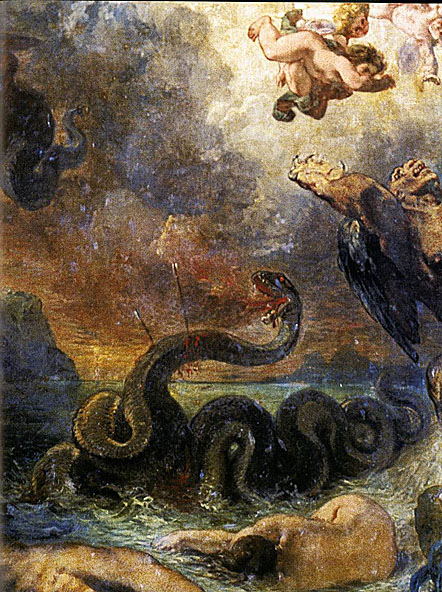
The work was fatiguing, and during these years he suffered from an increasingly fragile constitution. In addition to his home in Paris, from 1844 he also lived at a small cottage in Champrosay, where he found respite in the countryside. From 1834 until his death, he was faithfully cared for by his housekeeper, Jeanne-Marie le Guillou, who zealously guarded his privacy, and whose devotion prolonged his life and his ability to continue working in his later years.
In 1862 Delacroix participated in the creation of the Société Nationale des Beaux-Arts. His friend, the writer Théophile Gautier, became chairman, with the painter Aimé Millet acting as deputy chairman. In addition to Delacroix, the committee was composed of the painters Carrier-Belleuse and Puvis de Chavannes. Among the exhibitors were Léon Bonnat, Jean-Baptiste Carpeaux, Charles-François Daubigny, Gustave Doré, and Édouard Manet. Just after his death in 1863, the society organized a retrospective exhibition of 248 paintings and lithographs by Delacroix- and ceased to mount any further exhibitions.
Eugène Delacroix died in Paris, France and was buried there in the Père Lachaise Cemetery.
His house, formerly situated along the canal of the Marne, is now near the exit of the motorway leading from Paris to central Germany.
At the sale of his work in 1864, 9,140 works were attributed to Delacroix, including 853 paintings, 1,525 pastels and water colors, 6,629 drawings, 109 lithographs, and over 60 sketch books. The number and quality of the drawings, whether done for constructive purposes or to capture a spontaneous movement, underscored his explanation, "Color always occupies me, but drawing preoccupies me."
Delacroix produced several fine self-portraits, and a number of memorable portraits which seem to have been done purely for pleasure, among which were the portrait of fellow artist Baron Schwiter, an inspired small oil of the violinist Nicolò Paganini, and a double portrait of his friends, the composer Frédéric Chopin and writer George Sand; the painting was cut after his death, but the individual portraits survive.
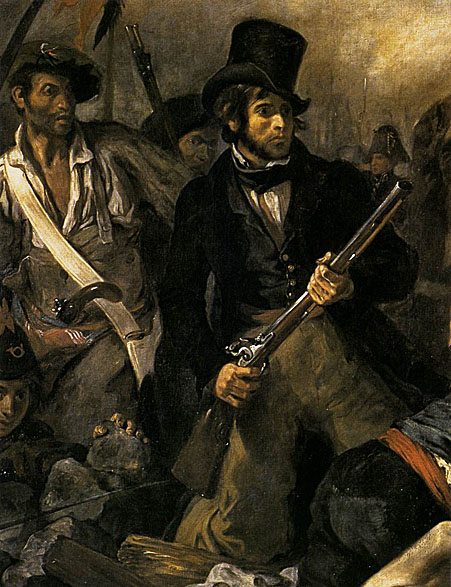
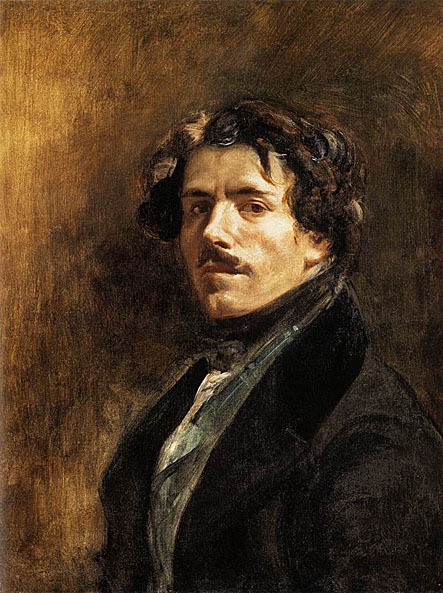
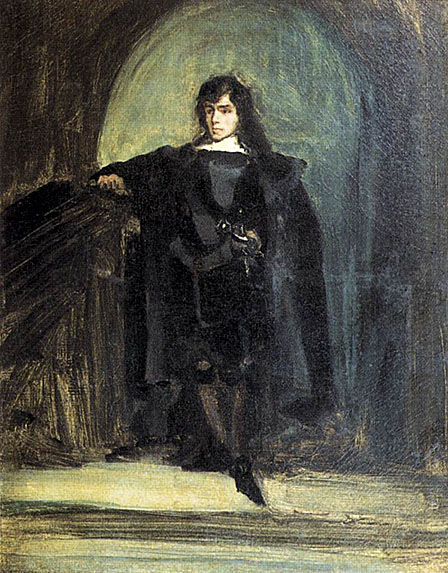
The most closely knit narrative in the Waverley series, The Bride of Lammermoor (1819), in the third group of Tales of my Landlord, is set against the tempestuous backdrop of the Glorious or Bloodless Revolution of 1688-9; it recounts the tale of the Ravenswood family, which chose to remain loyal to the Stuart cause when England's last Stuart king, James II, was deposed in favor of his Protestant son-in-law, William of Orange. Deprived of his title for his part in the Civil War and of his East Lothian estates by the devious Whig lawyer Sir William Ashton, the surviving son inherits his father's hatred of the upstart trickster Ashton whom he holds responsible for his father's dying of a fit. The somber young Master of Ravenswood lives on the only property left his family, the ruinous Wolf's Crag castle, attended by the faithful family retainer, Caleb Balderstone.
By chance, Ravenswood saves Ashton and his beautiful daughter, Lucy, from a stampede of Highland cattle. When political events raise friends to power, Ashton deems it advisable to agree to a match between his daughter and the young laird. Although her daughter has fallen in love with the Stuart sympathizer, Lady Ashton, an overbearing and virulent Whig adherent, returning home, cancels the marriage. Determined to see Lucy marry the Lord of Buclaw instead, Lady Ashton oppresses her daughter, who appears to yield, believing Ravenswood to have abandoned her after her mother has contemptuously dismissed him. Returning from a foreign mission on the day of the wedding, Ravenswood, challenges the new husband and Lucy's brother to a duel, but Lucy, going mad, stabs her husband on the wedding night, and shortly afterward dies. The next day, in his furious haste, to confront his enemies Ravenswood, forgetting the quick sand on the seashore, gallops to his doom.
The supernatural elements that support the ominous atmosphere (at once established by the opening funeral) seem related to the traditional ballads of the Scottish border, as does the elaborate use of symbolic imagery. The warning of Blind Alice, the wishing well, and the three witches in the kirkyard (obviously borrowed from Macbeth) all contribute to the Gothic background which dominates the action, fatalism conditioning the actions of the principal characters as the curse that foretells tragedy for the brooding hero and the innocent heroine works itself out relentlessly. Balderstone, the typical quirky servant in the tradition of Cervantes' Sancho Panza, provides the necessary comic relief through his attempts to provision Wolf's Crag and maintain the family's dignity in the face of poverty.
Since the action of the novel occurs just prior to the 1707 Act of Union between Scotland and England, approximately at the time of Queen Anne's accession, the novel seems intended to commemorate what Jane Millgate terms "the dying moments of Scotland's identity as a separate nation" (173). The demands of romance and melodrama determine that Ravenswood, like Scott's other heroes a noble youth with the potential for action, restrict the protagonist's freedom to act without regard to familial obligation, the code of vengeance, and societal superstition. Scott skillfully blends Spenserian romance and the latter-day Gothic conventions of Matthew G. "Monk" Lewis in his manipulation of the plot through supernatural agency and coincidence. Despite the use of dialect, especially in the dialogue of Balderstone, vocabulary and cultural differences apparently did not interfere with contemporary English readers' understandings of the plot and characters.
John Buchan contends that The Bride of Lammermoor is atypical of Scott's novels in that it ends tragically, with no hope for the future, its characters engulfed in a destiny beyond their control. The terrible darkness is only momentarily relieved by Caleb Balderstone's "raid" on the nearby village of Wolf's-hope in order to provision his master's castle for the unexpected reception of Sir William Ashton and his daughter. Scott wrote it, as Coleridge wrote "Kubla Khan," in a drugged and abnormal condition; in fact, having no recollection of its composition, he pronounced it "monstrous, gross and grotesque" at the completion of his first reading. The essential contrast of the book is between the nouveau riche, "Whig" nobility exemplified by the Ashtons, middle class entrepreneurs raised by the House of Hanover to the governing class, and the poverty and pride of the traditional land-owning class, exemplified by Ravenswood. The story's single concession to sentimentality is the large sable feather's floating on the rising tide to Caleb's feet after his Lord's perishing in the quicksands of Kelpie's Flow: "The old man took it up, dried it, and placed it in his bosom" (Ch. XXXV). The novel's great strength, contends Buchan, is Scott's handling of descriptions of the East Lothian landscape, anticipating Hardy's animation of Egdon Heath in The Return of the Native (1878).
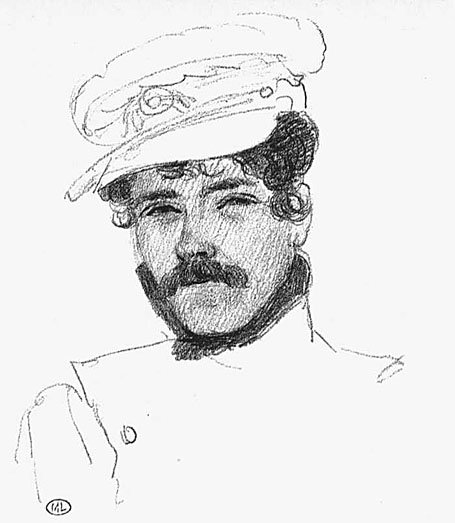
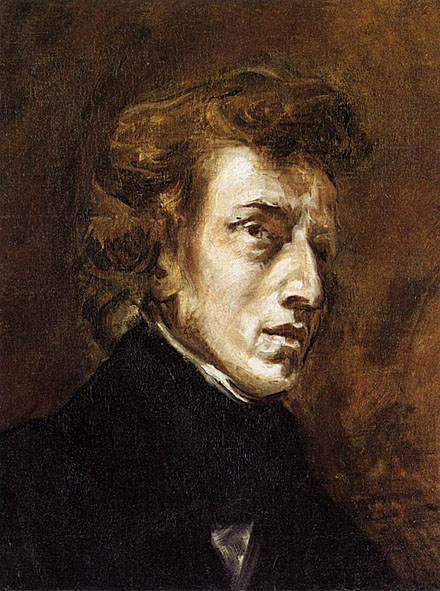
Frédéric François Chopin (1810-1849) was a Polish pianist and composer. He is widely regarded as one of the most famous, influential and admired composers for the piano.
He was born Fryderyk Franciszek Chopin in the village of Zelazowa Wola, Poland, to a Polish mother and French expatriate father. Hailed as a child prodigy in his homeland, Chopin left for Paris at the age of 20. In Paris, he made a career as a performer and teacher as well as a composer, and adopted the French variant of his name, "Frédéric-François". He had a turbulent 10-year relationship with the French writer George Sand from 1837 to 1847. Always in fragile health, he succumbed to pulmonary tuberculosis at the age of 39.

A generation of impressionists was inspired by Delacroix's work. Renoir and Manet made copies of his paintings, and Degas purchased the portrait of Baron Schwiter for his private collection. His painting at the church of St. Sulpice has been called the "finest mural painting of his time".
On occasion Delacroix painted pure landscapes (The Sea at Dieppe, 1852) and still-lifes (Still Life with Lobsters, 1826-7), both of which feature the virtuoso execution of his figure-based works. He is also well known for his Journals, in which he gave eloquent expression to his thoughts on art and contemporary life.
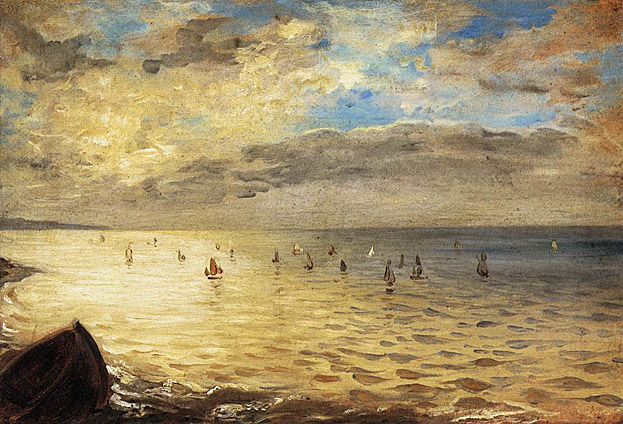
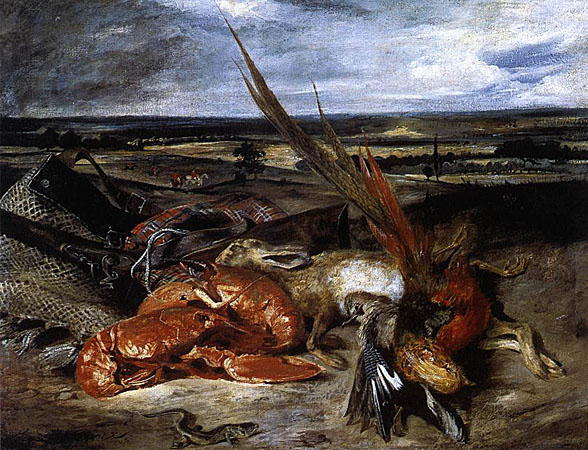
Of all Delacroix's paintings, the Still-Life with Lobster reveals most clearly the impression made on the young artist by English painting. The background with its red-coated huntsmen is reminiscent of landscapes by Constable; the dead game in the foreground, and the incongruous lobster, rival the finest details in the works of Jan Fyt.
Delacroix painted this picture when he returned from England; even before then, he was in close touch with English painters in Paris - Fielding and Bonington amongst others. But it was at the Salon of 1824 that he discovered the revolution which Constable had brought about in English painting, when he saw the three landscapes which the latter was exhibiting there. He hastily repainted the background of the Massacre of Scio along much the same lines; when the state bought the picture from him for 6,000 francs (a considerable sum in those days) he lost no time in spending the money on a trip to England. This opened up a new world to him: the Parthenon marbles, the Gothic style, the paintings of Lawrence and Etty, the horses (his host was the horsedealer Elmore), sailing in a yacht - a sport he was able to indulge in with an aristocratic friend of Elmore's - and the plays of Shakespeare. English painting had attracted a whole colony of French artists to London; among them Eugène Isabey, Eugène Lami, and Henri Monnier. Delacroix also renewed contact with Bonington, and worked in company with him. He was in London when he heard of the heroic death of Lord Byron, to whom he pays tribute in his Journal.
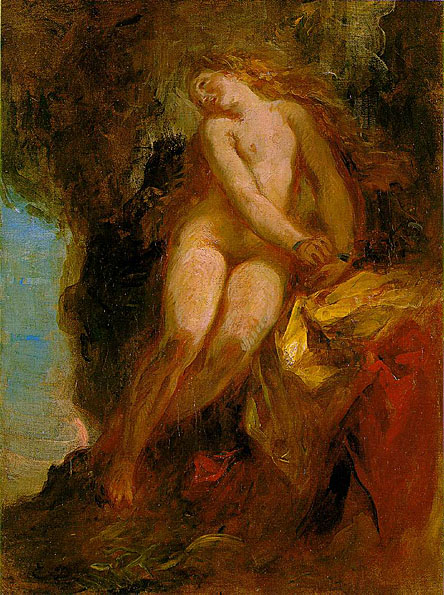
Her mother Cassiopeia bragged that she was more beautiful than the Nereids, the nymph-daughters of the sea god Nereus and often seen accompanying Poseidon. To punish the Queen for her arrogance, Poseidon, brother to Zeus and God of the Sea, sent a sea monster, Cetus, to ravage the coast of Ethiopia and the kingdom of the vain Queen. The desperate King consulted the Ammon, the Oracle of Zeus, who announced that no respite would be found until the king sacrificed his virgin daughter Andromeda to the monster. She was duly chained to a rock on the coast.
Perseus, returning from having slain the Gorgon Medusa, found Andromeda and slew the monster Cetus. He set her free, and married her in spite of Andromeda having been previously promised to Phineus. At the wedding a quarrel took place between the rivals, and Phineus was turned to stone by the sight of the Gorgon's head.
Andromeda followed her husband to Tiryns in Argos, and together they became the ancestors of the family of the Perseidae through the line of their son Perses. Perseus and Andromeda had six sons Perseides, Perses, Alcaeus, Heleus, Mestor, Sthenelus, and Electryon, and one daughter, Gorgophone. Their descendants ruled Mycenae from Electryon down to Eurystheus, after whom Atreus attained the kingdom, and would also include the great hero Heracles. According to this mythology, Perses is the ancestor of the Persians
. After her death she was placed by Athena amongst the constellations in the northern sky, near Perseus and Cassiopeia. Sophocles and Euripides (and in more modern times Corneille) made the story the subject of tragedies. The tale is represented in numerous ancient works of art.

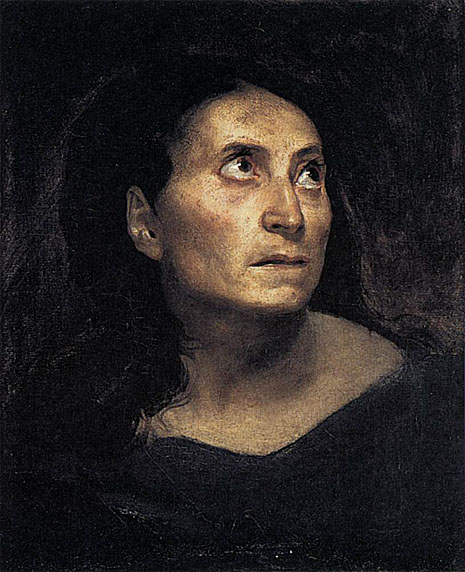
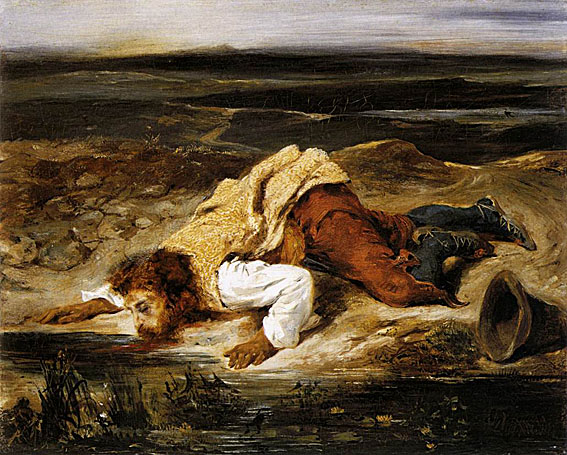

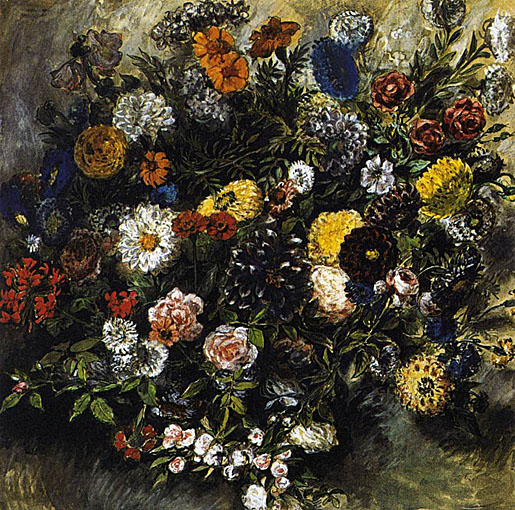
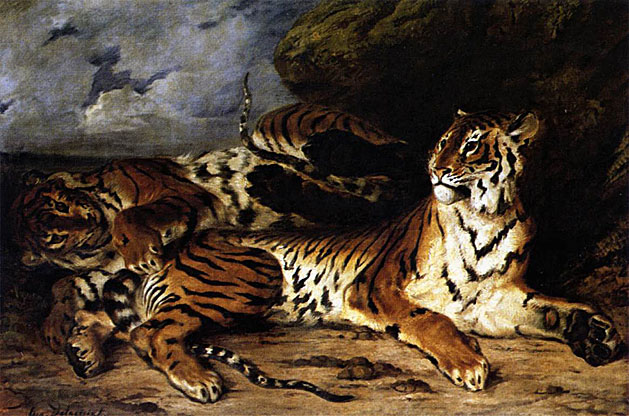
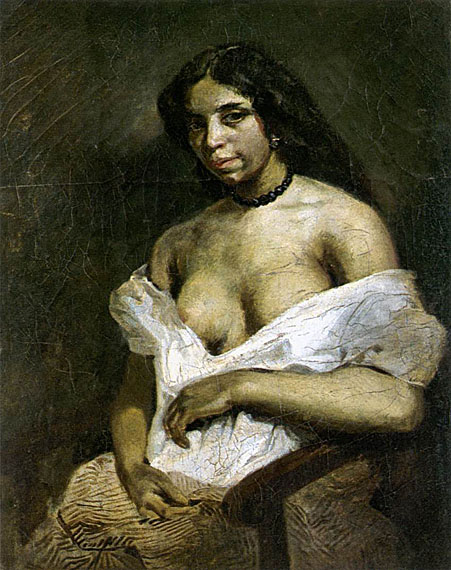
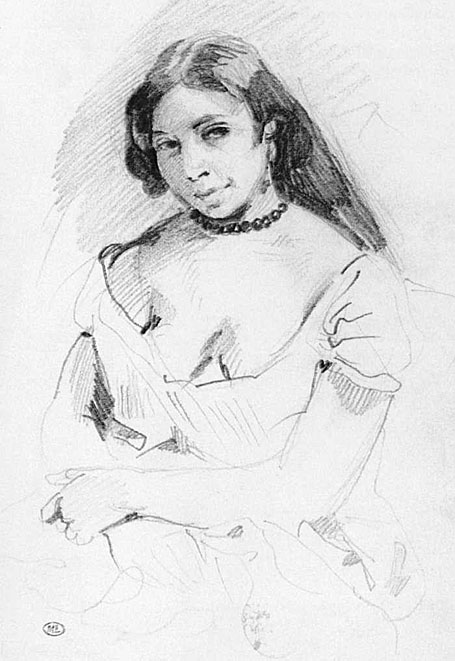
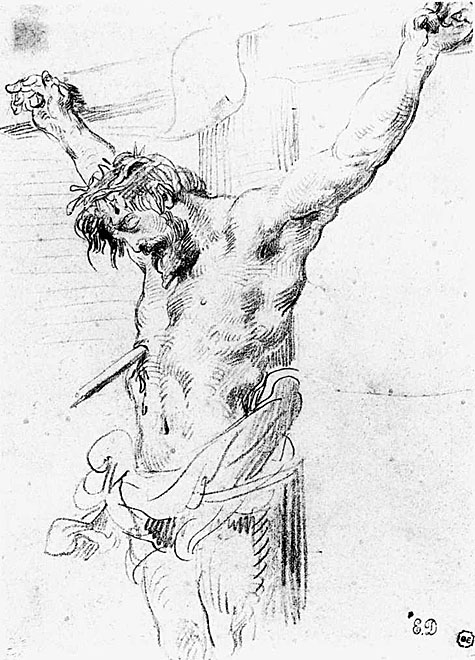
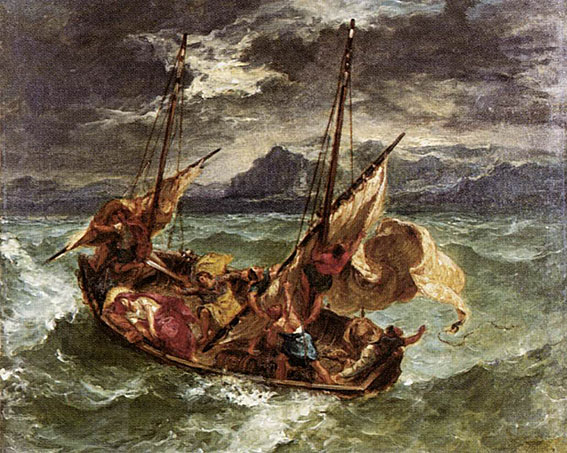
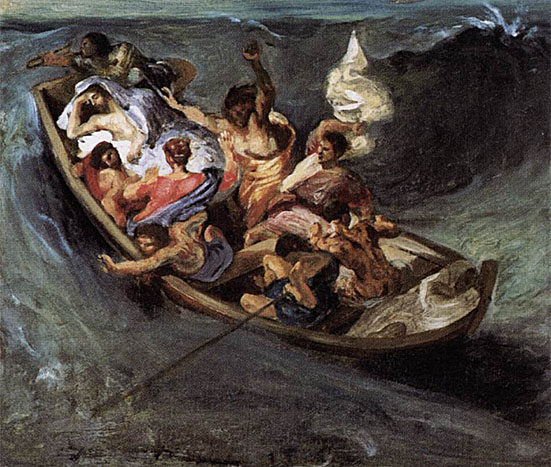

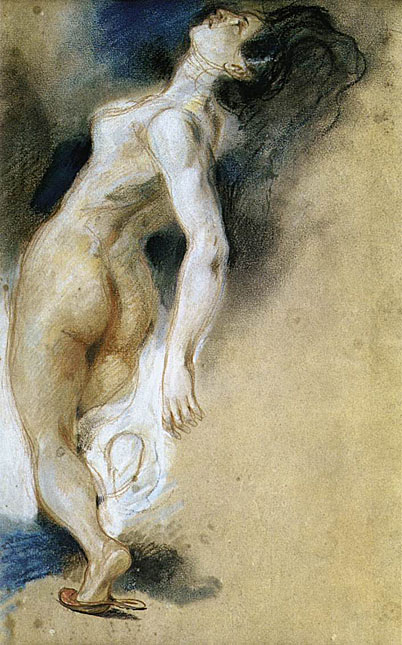
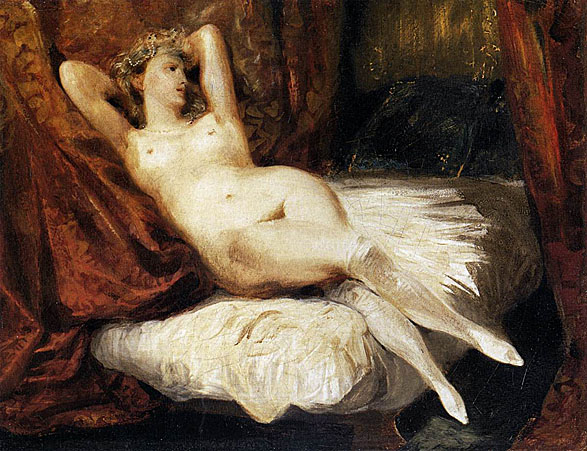
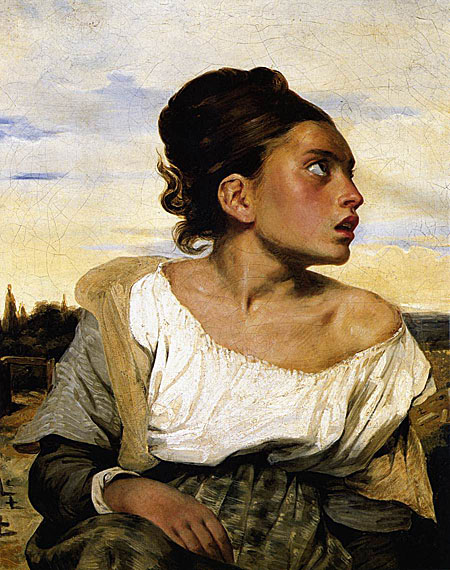

The Shakespearean hero, imperfect, immoderate and immature, was perfectly adapted to Delacroix's temperament, and gave free rein to his imagination; in his hands, the hero could be completed and perfected. It was, of course, Hamlet who most fascinated Delacroix.
"Alas, poor Yorick! - I knew him, Horatio: a fellow of most infinite jest..." (Act V, Scene 1). The scene of Hamlet and Horatio in the Graveyard inspired a painting and a series of lithographs which mirror the development of his art as a whole.
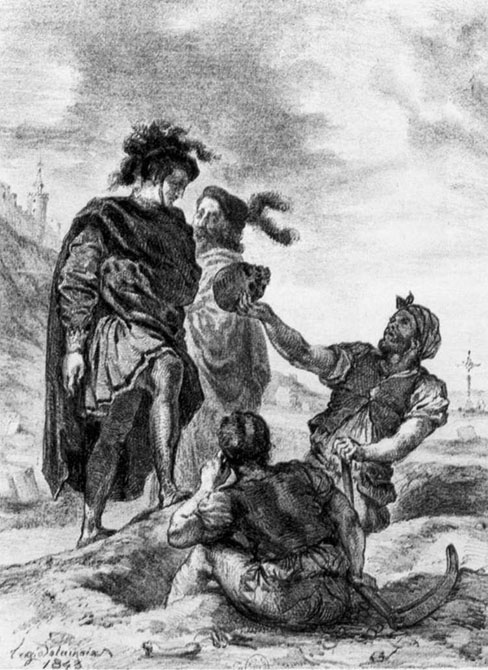
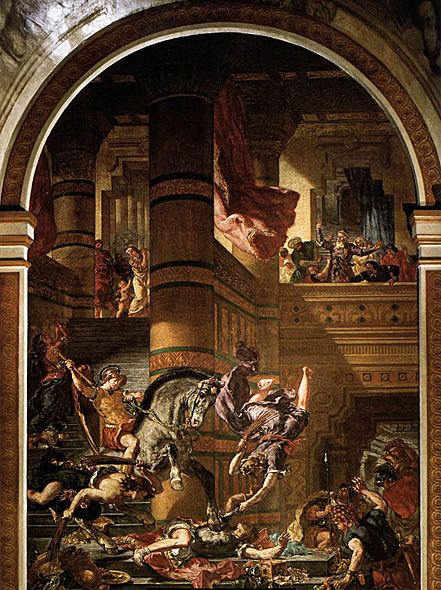
The Expulsion of Heliodorus illustrates the biblical episode (2 Maccabees, 3:21-28) of Heliodorus, sent by the king of Syria Seleucus, to take over the treasure preserved in the temple of Jerusalem. At the request of the high priest Onias, God sends a horseman assisted by two youths who beatt and banish Heliodorus. The commissioning pontiff has himself shown as witnessing the scene (in the foreground on the left) seated in the gestatorial chair, carried on the shoulders of the chair bearers. Of these, that on the left is a portrait of Marcantonio Raimondi, engraver and friend of Raphael, who is himself portrayed in the other figure to the right.
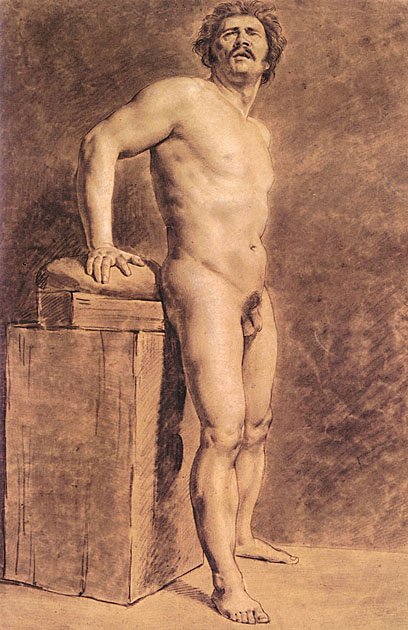
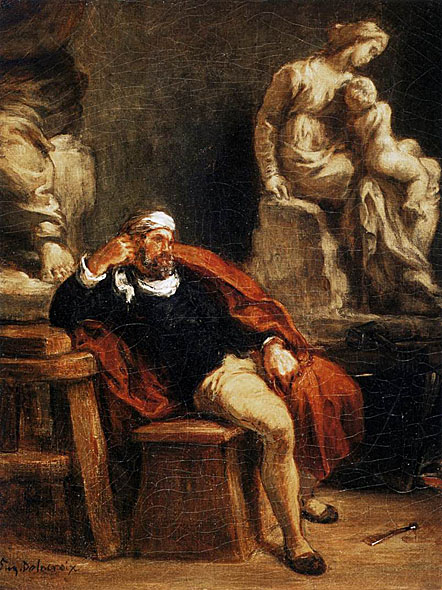
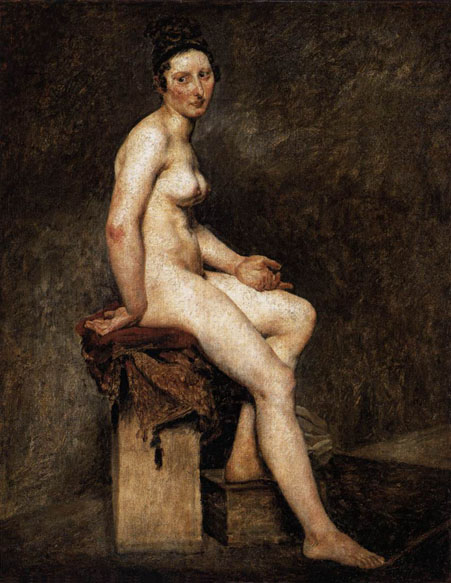

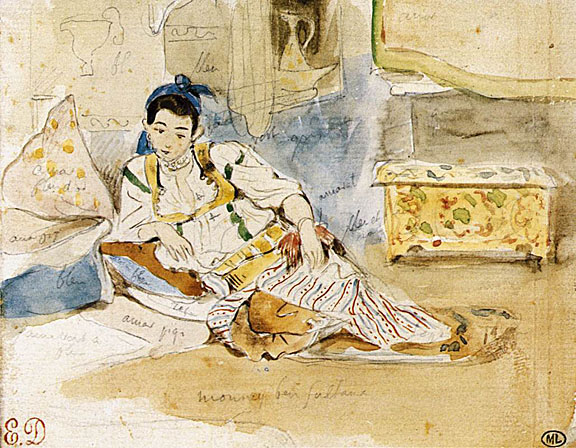
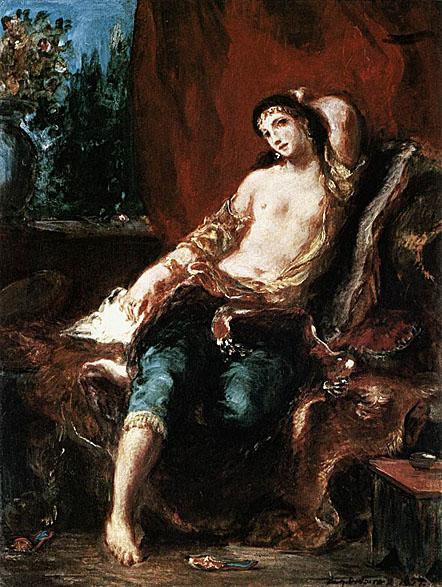

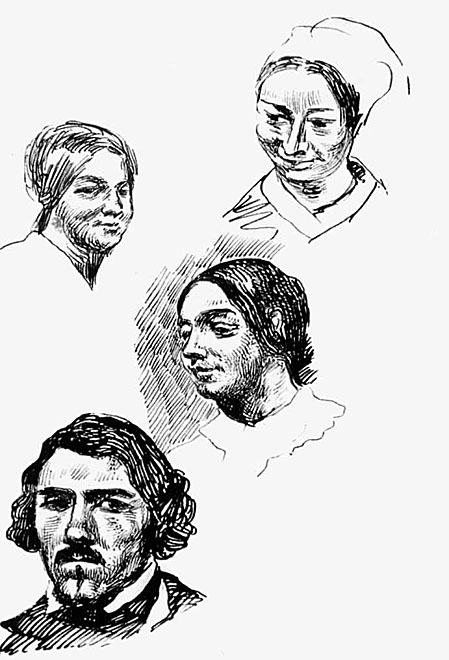
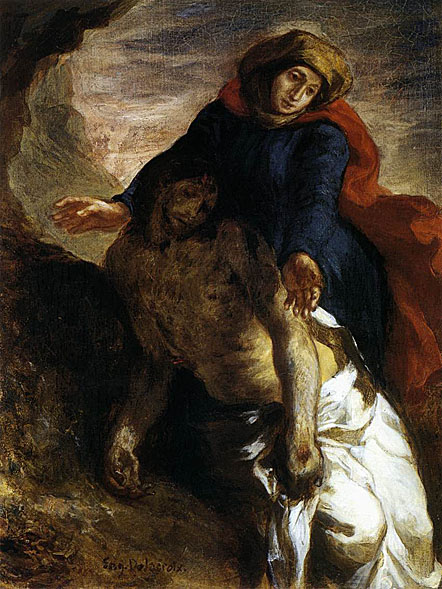
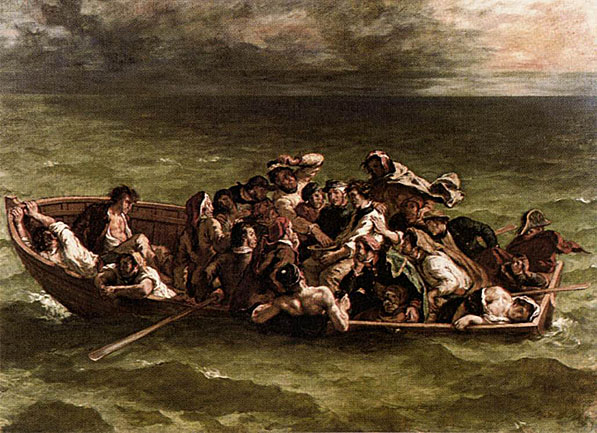
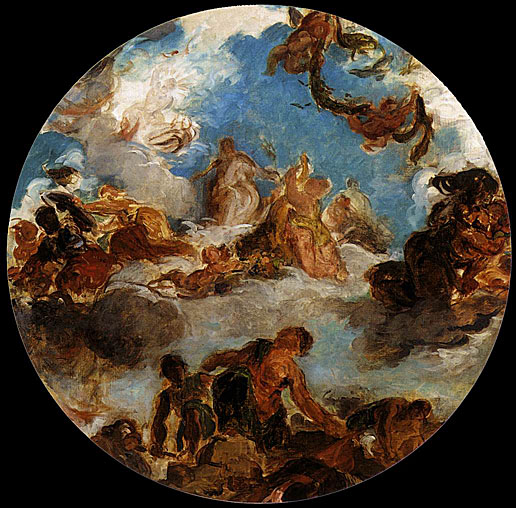

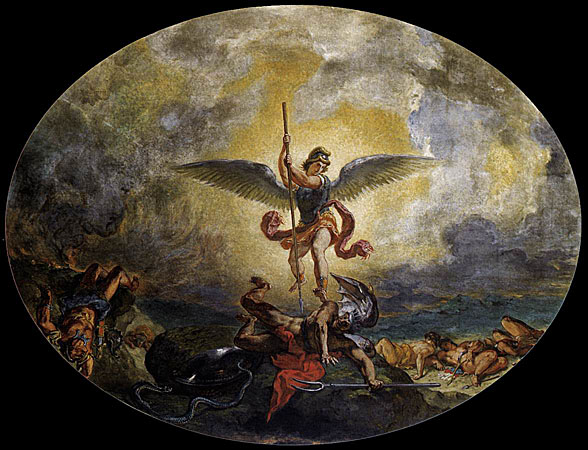
This time there was no critical consensus. There was praise for the delicate gradation of tones in the Heliodorus, which was compared to Veronese and Raphael, while Michelangelo was cited in relation to the muscular brutality of Jacob. But contemporary critics were blind to Delacroix's originality in replacing the traditional architectural background with a natural landscape. His very rich and various palette, the harmony of the colors, and, in particular, the subtlety of the greens in the foliage, prefigure the work of Corot. Delacroix here shows himself the father of Impressionism. Jacob Wrestling with the Angel has been read as a summary of Delacroix's life and work. Indeed the leitmotif of his career is the struggle - a spiritual combat - between his aspiration to classicism and his Romantic genius, between his admiration for Racine and his love of Shakespeare.
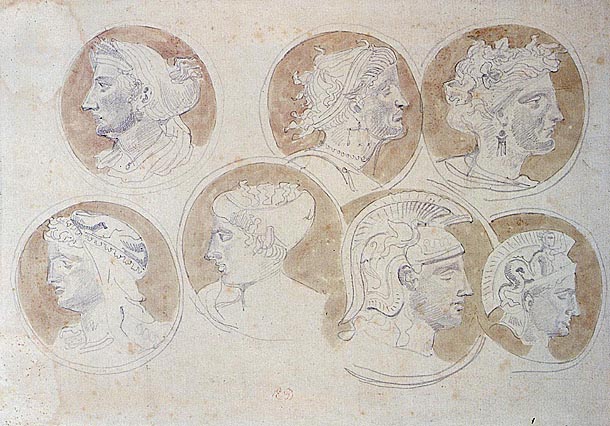

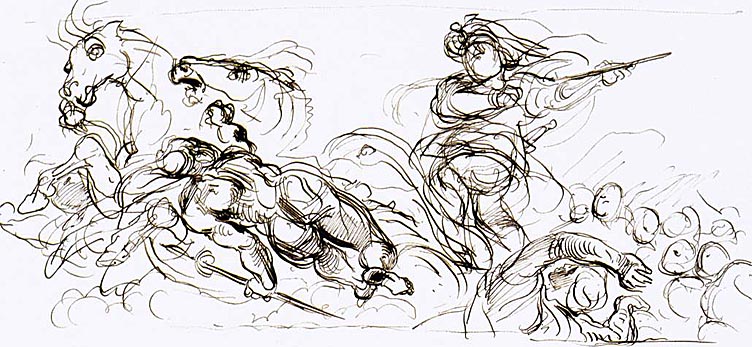
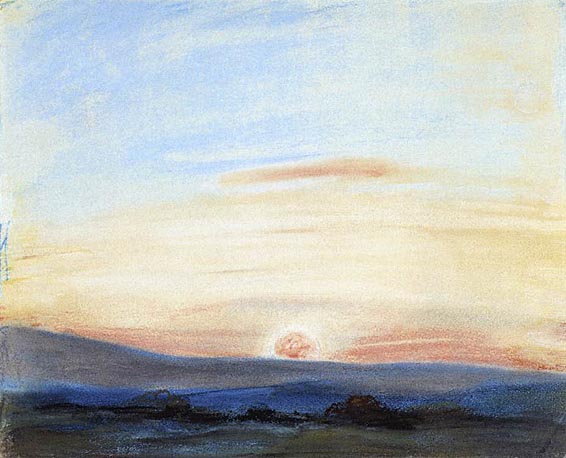
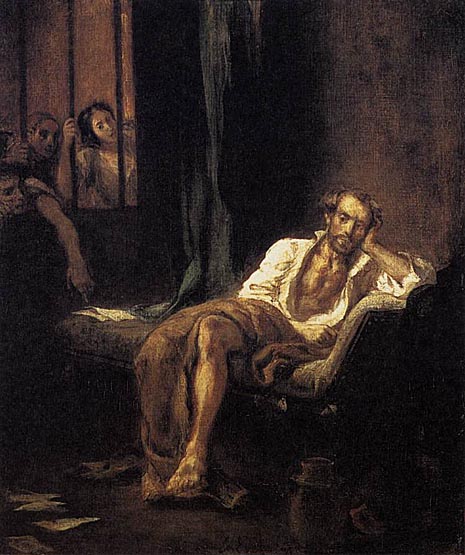
For Romantics like Delacroix, Tasso, shut up in his Ferrarese prison, was to be the epitome of the artist-hero who suffers for his art and beliefs.
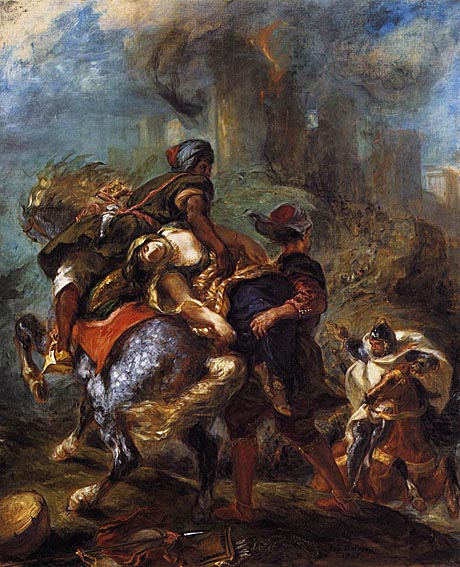
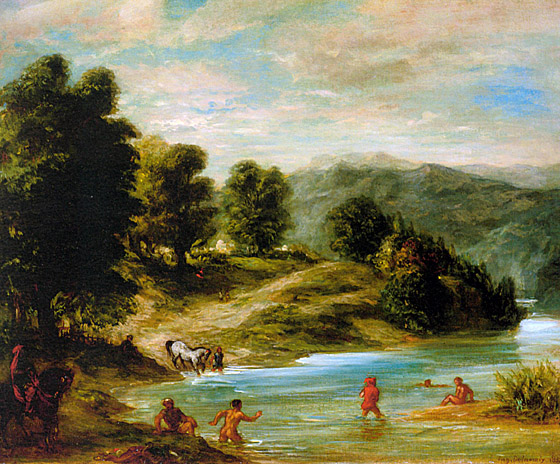
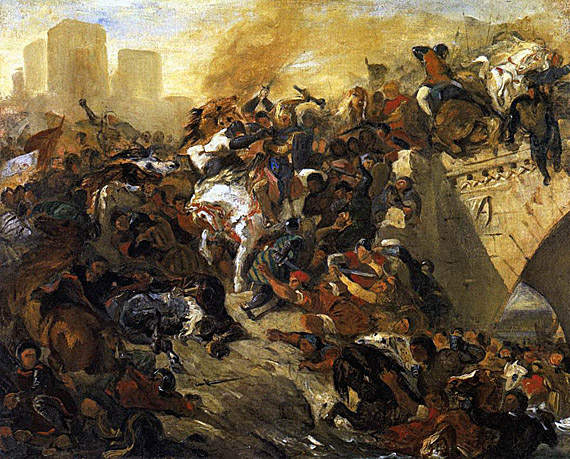
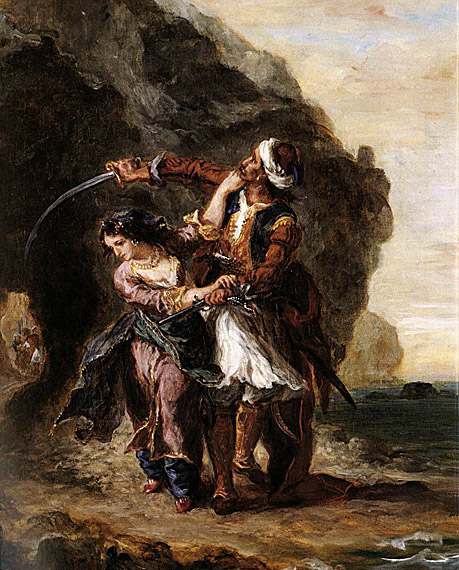
"Had we never loved so kindly,
Had we never loved so blindly,
Never met or never parted,
We had ne'er been broken-hearted." — Burns
TO
THE RIGHT HONOURABLE LORD HOLLAND,
THIS TALE IS INSCRIBED,
WITH EVERY SENTIMENT OF REGARD AND RESPECT,
BY HIS GRATEFULLY OBLIGED AND SINCERE FRIEND,
BYRON
THE BRIDE OF ABYDOS
CANTO THE FIRST
I
Know ye the land where cypress and myrtle
Are emblems of deeds that are done in their clime,
Where the rage of the vulture, the love of the turtle,
Now melt into sorrow, now madden to crime?
Know ye the land of the cedar and vine,
Where the flowers ever blossom, the beams ever shine;
Where the light wings of Zephyr, oppress'd with perfume,
Wax faint o'er the gardens of Gúl in her bloom;
Where the citron and olive are fairest of fruit,
And the voice of the nightingale never is mute;
Where the tints of the earth, and the hues of the sky,
In colour though varied, in beauty may vie,
And the purple of Ocean is deepest in dye;
Where the virgins are soft as the roses they twine,
And all, save the spirit of man, is divine?
'Tis the clime of the East; 'tis the land of the Sun
Can he smile on such deeds as his children have done?
Oh! wild as the accents of lovers' farewell
Are the hearts which they bear, and the tales which they tell.
II
Begirt with many a gallant slave,
Apparell'd as becomes the brave,
Awaiting each his lord's behest
To guide his steps, or guard his rest,
Old Giaffir sate in his Divan:
Deep thought was in his aged eye;
And though the face of Mussulman
Not oft betrays to standers by
The mind within, well skill'd to hide
All but unconquerable pride,
His pensive cheek and pondering brow
Did more than he wont avow.
III
"Let the chamber be clear'd." — The train disappear'd
"Now call me the chief of the Haram guard."
With Giaffir is none but his only son,
And the Nubian awaiting the sire's award.
"Haroun — when all the crowd that wait
Are pass'd beyond the outer gate,
(Woe to the head whose eye beheld
My child Zuleika's face unveil'd!)
Hence, lead my daughter from her tower:
Her fate is fix'd this very hour:
Yet not to her repeat my thought;
By me alone be duty taught!"
"Pacha! to hear is to obey."
No more must slave to despot say
Then to the tower had ta'en his way,
But here young Selim silence brake,
First lowly rendering reverence meet!
And downcast look'd, and gently spake,
Still standing at the Pacha's feet:
For son of Moslem must expire,
Ere dare to sit before his sire!
"Father! for fear that thou shouldst chide
My sister, or her sable guide,
Know — for the fault, if fault there be,
Was mine — then fall thy frowns on me
So lovelily the morning shone,
That — let the old and weary sleep
I could not; and to view alone
The fairest scenes of land and deep,
With none to listen and reply
To thoughts with which my heart beat high
Were irksome — for whate'er my mood,
In sooth I love not solitude;
I on Zuleika's slumber broke,
And as thou knowest that for me
Soon turns the Haram's grating key,
Before the guardian slaves awoke
We to the cypress groves had flown,
And made earth, main, and heaven our own!
There linger'd we, beguil'd too long
With Mejnoun's tale, or Sadi's song,
Till I, who heard the deep tambour
Beat thy Divan's approaching hour,
To thee, and to my duty true,
Warn'd by the sound, to greet thee flew:
But there Zuleika wanders yet
Nay, father, rage not — nor forget
That none can pierce that secret bower
But those who watch the women's tower."
IV
"Son of a slave" — the Pacha said
"From unbelieving mother bred,
Vain were a father's hope to see
Aught that beseems a man in thee.
Thou, when thine arm should bend the bow,
And hurl the dart, and curb the steed,
Thou, Greek in soul if not in creed,
Must pore where babbling waters flow,
And watch unfolding roses blow.
Would that yon orb, whose matin glow
Thy listless eyes so much admire,
Would lend thee something of his fire!
Thou, who wouldst see this battlement
By Christian cannon piecemeal rent;
Nay, tamely view old Stamboul's wall
Before the dogs of Moscow fall,
Nor strike one stroke for life or death
Against the curs of Nazareth!
Go — let thy less than woman's hand
Assume the distaff — not the brand.
But, Haroun! — to my daughter speed:
And hark — of thine own head take heed
If thus Zuleika oft takes wing
Thou see'st yon bow — it hath a string!"
V
No sound from Selim's lip was heard,
At least that met old Giaffir's ear,
But every frown and every word
Pierced keener than a Christian's sword.
"Son of a slave! — reproach'd with fear!
Those gibes had cost another dear.
Son of a slave! and who my sire?"
Thus held his thoughts their dark career,
And glances ev'n of more than ire
Flash forth, then faintly disappear.
Old Giaffir gazed upon his son
And started; for within his eye
He read how much his wrath had done;
He saw rebellion there begun:
"Come hither, boy — what, no reply?
I mark thee — and I know thee too;
But there be deeds thou dar'st not do:
But if thy beard had manlier length,
And if thy hand had skill and strength,
I'd joy to see thee break a lance,
Albeit against my own perchance."
As sneeringly these accents fell,
On Selim's eye he fiercely gazed:
That eye return'd him glance for glance,
And proudly to his sire's was raised,
Till Giaffir's quail'd and shrunk askance
And why — he felt, but durst not tell.
"Much I misdoubt this wayward boy
Will one day work me more annoy:
I never loved him from his birth,
And — but his arm is little worth,
And scarcely in the chase could cope
With timid fawn or antelope,
Far less would venture into strife
Where man contends for fame and life
I would not trust that look or tone:
No — nor the blood so near my own.
That blood — he hath not heard — no more
I'll watch him closer than before.
He is an Arab to my sight,
Or Christian crouching in the fight
But hark! — I hear Zuleika's voice;
Like Houris' hymn it meets mine ear:
She is the offspring of my choice;
Oh! more than ev'n her mother dear,
With all to hope, and nought to fear
My Peri! — ever welcome here!
Sweet, as the desert fountain's wave,
To lips just cool'd in time to save
Such to my longing sight art thou;
Nor can they waft to Mecca's shrine
More thanks for life, than I for thine,
Who blest thy birth, and bless thee now."
VI
Fair, as the first that fell of womankind,
When on that dread yet lovely serpent smiling,
Whose image then was stamp'd upon her mind
But once beguiled — and evermore beguiling;
Dazzling, as that, oh! too transcendent vision
To Sorrow's phantom-peopled slumber given,
When heart meets heart again in dreams Elysian,
And paints the lost on Earth revived in Heaven;
Soft, as the memory of buried love;
Pure as the prayer which Childhood wafts above,
Was she — the daughter of that rude old Chief,
Who met the maid with tears — but not of grief.
Who hath not proved how feebly words essay
To fix one spark of Beauty's heavenly ray?
Who doth not feel, until his failing sight
Faints into dimness with its own delight,
His changing cheek, his sinking heart confess
The might — the majesty of Loveliness?
Such was Zuleika — such around her shone
The nameless charms unmark'd by her alone;
The light of love, the purity of grace,
The mind, the Music breathing from her face,
The heart whose softness harmonised the whole
And, oh! that eye was in itself a Soul!
Her graceful arms in meekness bending
Across her gently-budding breast;
At one kind word those arms extending
To clasp the neck of him who blest
His child caressing and carest,
Zuleika came — Giaffir felt
His purpose half within him melt;
Not that against her fancied weal
His heart though stern could ever feel;
Affection chain'd her to that heart;
Ambition tore the links apart.
VII
"Zuleika! child of gentleness!
How dear this very day must tell,
When I forget my own distress,
In losing what I love so well,
To bid thee with another dwell:
Another! and a braver man
Was never seen in battle's van.
We Moslems reck not much of blood;
But yet the line of Carasman
Unchanged, unchangeable, hath stood
First of the bold Timariot bands
That won and well can keep their lands.
Enough that he who comes to woo
Is kinsman of the Bey Oglou:
His years need scarce a thought employ:
I would not have thee wed a boy.
And thou shalt have a noble dower:
And his and my united power
Will laugh to scorn the death-firman,
Which others tremble but to scan,
And teach the messenger what fate
The bearer of such boon may wait,
And now thy know'st thy father's will;
All that thy sex hath need to know:
'Twas mine to teach obedience still
The way to love, thy lord may show."
VIII
In silence bow'd the virgin's head;
And if her eye was fill'd with tears
That stifled feeling dare not shed,
And changed her cheek to pale to red,
And red to pale, as through her ears
Those winged words like arrows sped,
What could such be but maiden fears?
So bright the tear in Beauty's eye,
Love half regrets to kiss it dry;
So sweet the blush of Bashfulness,
Even Pity scarce can wish it less!
Whate'er it was the sire forgot;
Or if remember'd, mark'd it not;
Thrice clapp'd his hands, and call'd his steed,
Resign'd his gem-adorn'd chibouque,
And mounting featly for the mead,
With Maugrabee and Mamaluke,
His way amid his Delis took,
To witness many an active deed
With sabre keen, or blunt jerreed.
The Kislar only and his Moors
Watch well the Haram's massy doors.
IX
His head was leant upon his hand,
His eye look'd o'er the dark blue water
That swiftly glides and gently swells
Between the winding Dardanelles;
But yet he saw nor sea nor strand,
Nor even his Pacha's turban'd band
Mix in the game of mimic slaughter,
Careering cleave the folded felt
With sabre stroke right sharply dealt;
Nor mark'd the javelin-darting crowd,
Nor heard their Ollahs wild and loud
He thought but of old Giaffir's daughter!
X
No word from Selim's bosom broke;
One sigh Zuleika's thought bespoke:
Still gazed he through the lattice grate,
Pale, mute, and mournfully sedate.
To him Zuleika's eye was turn'd,
But little from his aspect learn'd;
Equal her grief, yet not the same:
Her heart confess'd a gentler flame:
But yet that heart, alarm'd, or weak,
She knew not why, forbade to speak.
Yet speak she must — but when essay?
"How strange he thus should turn away!
Not thus we e'er before have met;
Not thus shall be our parting yet."
Thrice paced she slowly through the room,
And watched his eye — it still was fix'd:
She snatch'd the urn wherein was mix'd
The Persian Atar-gúl's perfume,
And sprinkled all its odours o'er
The pictured roof and marble floor:
The drops, that through his glittering vest
The playful girl's appeal address'd,
Unheeded o'er his bosom flew,
As if that breast were marble too.
"What sullen yet? it must not be
Oh! gentle Selim, this from thee!"
She saw in curious order set
The fairest flowers of Eastern land
"He loved them once; may touch them yet
If offer'd by Zuleika's hand."
The childish thought was hardly breathed
Before the Rose was pluck'd and wreathed;
The next fond moment saw her seat
Her fairy form at Selim's feet:
"This rose to calm my brother's cares
A message from the Bulbul bears;
It says to-night he will prolong
For Selim's ear his sweetest song;
And though his note is somewhat sad,
He'll try for once a strain more glad,
With some faint hope his alter'd lay
May sing these gloomy thoughts away.
XI
"What! not receive my foolish flower?
Nay then I am indeed unblest:
On me can thus thy forehead lower?
And know'st thou not who loves thee best?
Oh, Selim dear! oh, more than dearest!
Say is it me thou hat'st or fearest?
Come, lay thy head upon my breast,
And I will kiss thee into rest,
Since words of mine, and songs must fail
Ev'n from my fabled nightingale.
I knew our sire at times was stern,
But this from thee had yet to learn:
Too well I know he loves thee not;
But is Zuleika's love forgot?
Ah! deem I right? the Pacha's plan
This kinsman Bey of Carasman
Perhaps may prove some foe of thine:
If so, I swear by Mecca's shrine,
If shrines that ne'er approach allow
To woman's step admit her vow,
Without thy free consent, command,
The Sultan should not have my hand!
Think'st though that I could bear to part
With thee, and learn to halve my heart?
Ah! were I sever'd from thy side,
Where were thy friend — and who my guide?
Years have not seen, Time shall not see
The hour that tears my soul from thee:
Even Azrael, [18] from his deadly quiver
When flies that shaft, and fly it must,
That parts all else, shall doom for ever
Our hearts to undivided dust!"
XII
He lived — he breathed — he moved — he felt;
He raised the maid from where she knelt;
His trance was gone — his keen eye shone
With thoughts that long in darkness dwelt;
With thoughts that burn — in rays that melt.
As the streams late conceal'd
By the fringe of its willows,
When it rushes reveal'd
In the light of its billows;
As the bolt bursts on high
From the black cloud that bound it,
Flash'd the soul of that eye
Through the long lashes round it.
A war-horse at the trumpet's sound,
A lion roused by heedless hound,
A tyrant waked to sudden strife
By graze of ill-directed knife,
Starts not to more convulsive life
Than he, who heard that vow, display'd,
And all, before repress'd, betray'd
"Now thou art mine, for ever mine,
With life to keep, and scarce with life resign;
Now thou art mine, that sacred oath,
Though sworn by one, hath bound us both.
Yes, fondly, wisely hast thou done;
That vow hath saved more heads than one:
But blench not thou — thy simplest tress
Claims more from me than tenderness;
I would not wrong the slenderest hair
That clusters round thy forehead fair,
For all the treasures buried far
Within the caves of Istakar.
This morning clouds upon me lower'd,
Reproaches on my head were shower'd,
And Giaffir almost call'd me coward!
Now I have motive to be brave;
The son of his neglected slave
Nay, start not, 'twas the term he gave
May shew, though little apt to vaunt,
A heart his words nor deeds can daunt.
His son, indeed! — yet, thanks to thee,
Perchance I am, at least shall be!
But let our plighted secret vow
Be only known to us as now.
I know the wretch who dares demand
From Giaffir thy reluctant hand;
More ill-got wealth, a meaner soul
Holds not a Musselim's control:
Was he not bred in Egripo?
A viler race let Israel show!
But let that pass — to none be told
Our oath; the rest let time unfold.
To me and mine leave Osman Bey;
I've partisans for peril's day:
Think not I am what I appear;
I've arms, and friends, and vengeance near."
XIII
"Think not thou art what thou appearest!
My Selim, thou art sadly changed:
This morn I saw thee gentlest, dearest:
But now thou'rt from thyself estranged.
My love thou surely knew'st before,
It ne'er was less, nor can be more.
To see thee, hear thee, near thee stay,
And hate the night, I know not why,
Save that we meet not but by day;
With thee to live, with thee to die,
I dare not to my hope deny:
Thy cheek, thine eyes, thy lips to kiss,
Like this — and this — no more than this;
For, Allah! Sure thy lips are flame:
What fever in thy veins is flushing?
My own have nearly caught the same,
At least I feel my cheek too blushing.
To soothe thy sickness, watch thy health,
Partake, but never waste thy wealth,
Or stand with smiles unmurmuring by,
And lighten half thy poverty;
Do all but close thy dying eye,
For that I could not live to try;
To these alone my thoughts aspire:
More can I do? or thou require?
But, Selim, thou must answer why
We need so much of mystery?
The cause I cannot dream nor tell,
But be it, since thou say'st 'tis well;
Yet what thou mean'st by 'arms' and 'friends,'
Beyond my weaker sense extends.
I mean that Giaffir should have heard
The very vow I plighted thee;
His wrath would not revoke my word:
But surely he would leave me free.
Can this fond wish seem strange in me,
To be what I have ever been?
What other hath Zuleika seen
From simple childhood's earliest hour?
What other can she seek to see
Than thee, companion of her bower,
The partner of her infancy?
These cherish'd thoughts with life begun,
Say, why must I no more avow?
What change is wrought to make me shun
The truth; my pride, and thine till now?
To meet the gaze of stranger's eyes
Our law, our creed, our God denies,
Nor shall one wandering thought of mine
At such, our Prophet's will, repine:
No! happier made by that decree!
He left me all in leaving thee.
Deep were my anguish, thus compell'd
To wed with one I ne'er beheld:
This wherefore should I not reveal?
Why wilt thou urge me to conceal!
I know the Pacha's haughty mood
To thee hath never boded good:
And he so often storms at naught,
Allah! forbid that e'er he ought!
And why I know not, but within
My heart concealment weighs like sin.
If then such secresy be crime,
And such it feels while lurking here,
Oh, Selim! tell me yet in time,
Nor leave me thus to thoughts of fear.
Ah! yonder see the Tchocadar,
My father leaves the mimic war:
I tremble now to meet his eye
Say, Selim, canst thou tell me why?"
XIV
"Zuleika — to thy tower's retreat
Betake thee — Giaffir I can greet:
And now with him I fain must prate
Of firmans, imposts, levies, state.
There's fearful news from Danube's banks,
Our Vizier nobly thins his ranks,
For which the Giaour may give him thanks!
Our sultan hath a shorter way
Such costly triumph to repay.
But, mark me, when the twilight drum
Hath warn'd the troops to food and sleep,
Unto thy cell will Selim come:
Then softly from the Haram creep
Where we may wander by the deep:
Our garden-battlements are steep;
Nor these will rash intruder climb
To list our words, or stint our time;
And if he doth, I want not steel
Which some have felt, and more may feel.
Then shalt thou learn of Selim more
Than thou hast heard or thought before:
Trust me, Zuleika — fear not me!
Thou know'st I hold a Haram key."
"Fear thee, my Selim! ne'er till now
Did word like this"
"Delay not thou;
I keep the key — and Haroun's guard
Have some, and hope of more reward.
Tonight, Zuleika, thou shalt hear
My tale, my purpose, and my fear:
I am not, love! what I appear."
CANTO THE SECOND
I
The winds are high on Helle's wave,
As on that night of stormy water,
When Love, who sent, forgot to save
The young, the beautiful, the brave,
The lonely hope of Sestos' daughter.
Oh! when alone along the sky
Her turret-torch was blazing high,
Though rising gale, and breaking foam,
And shrieking sea-birds warn'd him home;
And clouds aloft and tides below,
With signs and sounds, forbade to go,
He could not see, he would not hear,
Or sound or sign foreboding fear;
His eye but saw the light of love,
The only star it hail'd above;
His ear but rang with Hero's song,
"Ye waves, divide not lovers long!"
That tale is old, but love anew
May nerve young hearts to prove as true.
II
The winds are high, and Helle's tide
Rolls darkly heaving to the main;
And Night's descending shadows hide
That field with blood bedew'd in vain,
The desert of old Priam's pride;
The tombs, sole relics of his reign,
All — save immortal dreams that could beguile
The blind old man of Scio's rocky isle!
III
Oh! yet — for there my steps have been!
These feet have press'd the sacred shore,
These limbs that buoyant wave hath borne
Minstrel! with thee to muse, to mourn,
To trace again those fields of yore,
Believing every hillock green
Contains no fabled hero's ashes,
And that around the undoubted scene
Thine own "broad Hellespont" still dashes,
Be long my lot! and cold were he
Who there could gaze denying thee!
IV
The night hath closed on Helle's stream,
Nor yet hath risen on Ida's hill
That moon, which shoon on his high theme:
No warrior chides her peaceful beam,
But conscious shepherds bless it still.
Their flocks are grazing on the mound
Of him who felt the Dardan's arrow;
That mighty heap of gather'd ground
Which Ammon's son ran proudly round,
By nations raised, by monarchs crown'd,
Is now a lone and nameless barrow!
Within — thy dwelling-place how narrow?
Without — can only strangers breathe
The name of him that was beneath:
Dust long outlasts the storied stone;
But Thou — thy very dust is gone!
V
Late, late to-night will Dian cheer
The swain, and chase the boatman's fear;
Till then — no beacon on the cliff
May shape the course of struggling skiff;
The scatter'd lights that skirt the bay,
All, one by one, have died away;
The only lamp of this lone hour
Is glimmering in Zuleika's tower.
Yes! there is light in that lone chamber,
And o'er her silken Ottoman
Are thrown the fragrant beads of amber,
O'er which her fairy fingers ran;
Near these, with emerald rays beset,
(How could she thus that gem forget?)
Her mother's sainted amulet,
Whereon engraved the Koorsee text,
Could smooth this life, and win the next;
And by her Comboloio lies
A Koran of illumined dyes;
And many a bright emblazon'd rhyme
By Persian scribes redeem'd from time;
And o'er those scrolls, not oft so mute,
Reclines her now neglected lute;
And round her lamp of fretted gold
Bloom flowers in urns of China's mould;
The richest work of Iran's loom,
And Sheeraz' tribute of perfume;
All that can eye or sense delight
Are gather'd in that gorgeous room:
But yet it hath an air of gloom.
She, of this Peri cell the sprite,
What doth she hence, and on so rude a night?
VI
Wrapt in the darkest sable vest,
Which none save noblest Moslems wear,
To guard from winds of heaven the breast
As heaven itself to Selim dear,
With cautious steps the thicket threading,
And starting oft, as through the glade
The gust its hollow moanings made;
Till on the smoother pathway treading,
More free her timid bosom beat,
The maid pursued her silent guide;
And though her terror urged retreat,
How could she quit her Selim's side?
How teach her tender lips to chide?
VII
They reach'd at length a grotto, hewn
By nature, but enlarged by art,
Where oft her lute she wont to tune,
And oft her Koran conn'd apart:
And oft in youthful reverie
She dream'd what Paradise might be;
Where woman's parted soul shall go
Her Prophet had disdain'd to show;
But Selim's mansion was secure,
Nor deem'd she, could he long endure
His bower in other worlds of bliss,
Without her, most beloved in this!
Oh! who so dear with him could dwell?
What Houri soothe him half so well?
VIII
Since last she visited the spot
Some change seem'd wrought within the grot;
It might be only that the night
Disguised things seen by better light:
That brazen lamp but dimly threw
A ray of no celestial hue:
But in a nook within the cell
Her eye on stranger objects fell.
There arms were piled, not such as wield
The turban'd Delis in the field;
But brands of foreign blade and hilt,
And one was red — perchance with guilt!
Ah! how without can blood be spilt?
A cup too on the board was set
That did not seem to hold sherbet.
What may this mean? she turn'd to see
Her Selim — "Oh! can this be he?"
IX
His robe of pride was thrown aside,
His brow no high-crown'd turban bore
But in its stead a shawl of red,
Wreathed lightly round, his temples wore:
That dagger, on whose hilt the gem
Were worthy of a diadem,
No longer glitter'd at his waist,
Where pistols unadorn'd were braced;
And from his belt a sabre swung,
And from his shoulder loosely hung
The cloak of white, the thin capote
That decks the wandering Candiote:
Beneath — his golden plated vest
Clung like a cuirass to his breast
The greaves below his knee that wound
With silvery scales were sheathed and bound.
But were it not that high command
Spake in his eye, and tone, and hand,
All that a careless eye could see
In him was some young Galiongée.
X
"I said I was not what I seem'd;
And now thou see'st my words were true:
I have a tale thou hast not dream'd,
If sooth — its truth must others rue.
My story now 'twere vain to hide,
I must not see thee Osman's bride:
But had not thine own lips declared
How much of that young heart I shared,
I could not, must not, yet have shown
The darker secret of my own.
In this I speak not now of love;
That, let time, truth, and peril prove:
But first — oh! never wed another
Zuleika! I am not thy brother!"
XI
"Oh! not my brother! — yet unsay
God! am I left alone on earth
To mourn — I dare not curse the day
That saw my solitary birth?
Oh! thou wilt love me now no more!
My sinking heart foreboded ill;
But know me all I was before,
Thy sister — friend — Zuleika still.
Thou ledd'st me hear perchance to kill;
If thou hast cause for vengeance see
My breast is offer'd — take thy fill!
Far better with the dead to be
Than live thus nothing now to thee;
Perhaps far worse, for now I know
Why Giaffir always seem'd thy foe;
And I, alas! am Giaffir's child,
Form whom thou wert contemn'd, reviled.
If not thy sister — wouldst thou save
My life, oh! bid me be thy slave!"
XII
"My slave, Zuleika! — nay, I'm thine;
But, gentle love, this transport calm,
Thy lot shall yet be link'd with mine;
I swear it by our Prophet's shrine,
And be that thought thy sorrow's balm.
So may the Koran verse display'd
Upon its steel direct my blade,
In danger's hour to guard us both,
As I preserve that awful oath!
The name in which thy heart hath prided
Must change; but, my Zuleika, know,
That tie is widen'd, not divided,
Although thy Sire's my deadliest foe.
My father was to Giaffir all
That Selim late was deem'd to thee;
That brother wrought a brother's fall,
But spared, at least, my infancy;
And lull'd me with a vain deceit
That yet a like return may meet.
He rear'd me, not with tender help,
But like the nephew of a Cain;
He watch'd me like a lion's whelp,
That gnaws and yet may break his chain.
My father's blood in every vein
Is boiling; but for thy dear sake
No present vengeance will I take;
Though here I must no more remain.
But first, beloved Zuleika! hear
How Giaffir wrought this deed of fear.
XIII
"How first their strife to rancour grew,
If love or envy made them foes,
It matters little if I knew;
In fiery spirits, slights, though few
And thoughtless, will disturb repose.
In war Abdallah's arm was strong,
Remember'd yet in Bosniac song,
And Paswan's rebel hordes attest
How little love they bore such guest:
His death is all I need relate,
The stern effect of Giaffir's hate;
And how my birth disclosed to me,
Whate'er beside it makes, hath made me free.
XIV
"When Paswan, after years of strife,
At last for power, but first for life,
In Widdin's walls too proudly sate,
Our Pachas rallied round the state;
Nor last nor least in high command,
Each brother led a separate band;
They gave their horse-tails to the wind,
And mustering in Sophia's plain
Their tents were pitch'd, their posts assign'd;
To one, alas! assign'd in vain!
What need of words? the deadly bowl,
By Giaffir's order drugg'd and given,
With venom subtle as his soul,
Dismiss'd Abdallah's hence to heaven.
Reclined and feverish in the bath,
He, when the hunter's sport was up,
But little deem'd a brother's wrath
To quench his thirst had such a cup:
The bowl a bribed attendant bore;
He drank one draught, and nor needed more!
If thou my tale, Zuleika, doubt,
Call Haroun — he can tell it out.
XV
"The deed once done, and Paswan's feud
In part suppress'd, though ne'er subdued,
Abdallah's Pachalic was gain'd:
Thou know'st not what in our Divan
Can wealth procure for worse than man
Abdallah's honours were obtain'd
By him a brother's murder stain'd;
'Tis true, the purchase nearly drain'd
His ill got treasure, soon replaced.
Wouldst question whence? Survey the waste,
And ask the squalid peasant how
His gains repay his broiling brow!
Why me the stern usurper spared,
Why thus with me the palace shared,
I know not. Shame, regret, remorse,
And little fear from infant's force;
Besides, adoption of a son
Of him whom Heaven accorded none,
Or some unknown cabal, caprice,
Preserved me thus; but not in peace;
He cannot curb his haughty mood,
Nor I forgive a father's blood!
XVI
"Within thy father's house are foes;
Not all who break his bread are true:
To these should I my birth disclose,
His days, his very hours, were few:
They only want a heart to lead,
A hand to point them to the deed.
But Haroun only knows — or knew
This tale, whose close is almost nigh:
He in Abdallah's palace grew,
And held that post in his Serai
Which holds he here — he saw him die:
But what could single slavery do?
Avenge his lord? alas! too late;
Or save his son from such a fate?
He chose the last, and when elate
With foes subdued, or friends betray'd,
Proud Giaffir in high triumph sate,
He led me helpless to his gate,
And not in vain it seems essay'd
To save the life for which he pray'd.
The knowledge of my birth secured
From all and each, but most from me;
Thus Giaffir's safety was insured.
Removed he too from Roumelie
To this our Asiatic side,
Far from our seat by Danube's tide,
With none but Haroun, who retains
Such knowledge — and that Nubian feels
A tyrant's secrets are but chains,
From which the captive gladly steals,
And this and more to me reveals:
Such still to guilt just Allah sends
Slaves, tools, accomplices — no friends!
XVII
"All this, Zuleika, harshly sounds;
But harsher still my tale must be:
Howe'er my tongue thy softness wounds,
Yet I must prove all truth to thee.
I saw thee start this garb to see,
Yet is it one I oft have worn,
And long must wear: this Galiongée,
To whom thy plighted vow is sworn,
Is leader of those pirate hordes,
Whose laws and lives are on their swords;
To hear whose desolating tale
Would make thy waning cheek more pale:
Those arms thou see'st my band have brought,
The hands that wield are not remote;
This cup too for the rugged knaves
Is fill'd — once quaff'd, they ne'er repine:
Our Prophet might forgive the slaves;
They're only infidels in wine!
XVIII
"What could I be? Proscribed at home,
And taunted to a wish to roam;
And listless left — for Giaffir's fear
Denied the courser and the spear
Though oft — oh, Mohammed! how oft!
In full Divan the despot scoff'd,
As if my weak unwilling hand
Refused the bridle or the brand:
He ever went to war alone,
And pent me here untried — unknown;
To Haroun's care with women left,
By hope unblest, of fame bereft.
While thou — whose softness long endear'd,
Though it unmann'd me, still had cheer'd
To Brusa's walls for safety sent,
Awaited'st there the field's event.
Haroun, who saw my spirit pining
Beneath inaction's sluggish yoke,
His captive, though with dread, resigning,
My thraldom for a season broke,
On promise to return before
The day when Giaffir's charge was o'er.
'Tis vain — my tongue can not impart
My almost drunkenness of heart,
When first this liberated eye
Survey'd Earth, Ocean, Sun and Sky,
As if my spirit pierced them through,
And all their inmost wonders knew!
One word alone can paint to thee
That more than feeling — I was Free!
Ev'n for thy presence ceased to pine;
The World — nay — Heaven itself was mine!
XIX
"The shallop of a trusty Moor
Convey'd me from this idle shore;
I long'd to see the isles that gem
Old Ocean's purple diadem:
I sought by turns, and saw them all:
But when and where I join'd the crew,
With whom I'm pledged to rise or fall,
When all that we design to do
Is done, 'twill then be time more meet
To tell thee, when the tale's complete.
XX
"'Tis true, they are a lawless brood,
But rough in form, nor mild in mood;
With them hath found — may find — a place:
But open speech, and ready hand,
Obedience to their chief's command;
A soul for every enterprise,
That never sees with terror's eyes;
Friendship for each, and faith to all,
And vengeance vow'd for those who fall,
Have made them fitting instruments
For more than ev'n my own intents.
And some — and I have studied all
Distinguish'd from the vulgar rank,
But chiefly to my council call
The wisdom of the cautious Frank
And some to higher thoughts aspire,
The last of Lambro's patriots there
Anticipated freedom share;
And oft around the cavern fire
On visionary schemes debate,
To snatch the Rayahs from their fate.
So let them ease their hearts with prate
Of equal rights, which man ne'er knew;
I have a love of freedom too.
Ay! let me like the ocean-Patriarch roam,
Or only known on land the Tartar's home!
My tent on shore, my galley on the sea,
Are more than cities and Serais to me:
Borne by my steed, or wafted by my sail,
Across the desert, or before the gale,
Bound where thou wilt, my barb! or glide, my prow!
But be the star that guides the wanderer, Thou!
Thou, my Zuleika! share and bless my bark;
The Dove of peace and promise to mine ark!
Or, since that hope denied in worlds of strife,
Be thou the rainbow to the storms of life!
The evening beam that smiles the cloud away,
And tints to-morrow with prophetic ray!
Blest — as the Muezzin's strain from Mecca's wall
To pilgrims pure and prostrate at his call;
Soft — as the melody of youthful days,
That steals the trembling tear of speechless praise;
Dear — as his native song to exile's ears,
Shall sound each tone thy long-loved voice endears.
For thee in those bright isles is built a bower
Blooming as Aden in its earliest hour.
A thousand swords, with Selim's heart and hand,
Wait — wave — defend — destroy — at thy command!
Girt by my band, Zuleika at my side,
The spoil of nations shall bedeck my bride.
The Haram's languid years of listless ease
Are well resign'd for cares — for joys like these:
Not blind to fate, I see, where'er I rove,
Unnumber'd perils — but one only love!
Yet well my toils shall that fond beast repay,
Though fortune frown or falser friends betray.
How dear the dream in darkest hours of ill,
Should all be changed, to find thee faithful still!
Be but thy soul, like Selim's, firmly shown;
To thee be Selim's tender as thine own;
To soothe each sorrow, share in each delight,
Blend every thought, do all — but disunite!
Once free, 'tis mine our horde again to guide;
Friends to each other, foes to aught beside:
Yet there we follow but the bent assign'd
By fatal Nature to man's warring kind:
Mark! where his carnage and his conquests cease!
He makes a solitude, and calls it — peace!
I like the rest must use my skill or strength,
But ask no land beyond my sabre's length:
Power sways but by division — her resource
The blest alternative of fraud or force!
Ours be the last; in time deceit may come
When cities cage us in a social home:
There ev'n thy soul might err — how oft the heart
Corruption shakes which peril could not part!
And woman, more than man, when death or woe,
Or even disgrace, would lay her lover low,
Sunk in the lap of luxury will shame
Away suspicion! — not Zuleika's name!
But life is hazard at the best; and here
No more remains to win, and much to fear:
Yes, fear! — the doubt, the dread of losing thee,
By Osman's power, and Giaffir's stern decree.
That dread shall vanish with the favouring gale,
Which Love to-night hath promised to my sail:
No danger daunts the pair his smile hath blest,
Their steps till roving, but their hearts at rest.
With thee all toils are sweet, each clime hath charms;
Earth — sea alike — our world within our arms!
Ay — let the loud winds whistle o'er the deck,
So that those arms cling closer round my neck:
The deepest murmur of this lip shall be
No sigh for safety, but a prayer for thee!
The war of elements no fears impart
To Love, whose deadliest bane is human Art:
There lie the only rocks our course can check;
Here moments menace — there are years of wreck!
But hence ye thoughts that rise in Horror's shape!
This hour bestows, or ever bars escape.
Few words remain of mine my tale to close:
Of thine but one to waft us from our foes;
Yea — foes — to me will Giaffir's hate decline?
And is not Osman, who would part us, thine?
XXI
"His head and faith from doubt and death
Return'd in time my guard to save;
Few heard, none told, that o'er the wave
From isle to isle I roved the while:
And since, though parted from my band
Too seldom now I leave the land,
No deed they've done, nor deed shall do,
Ere I have heard and doom'd it too:
I form the plan, decree the spoil,
'Tis fit I oftener share the toil.
But now too long I've held thine ear;
Time presses, floats my bark, and here
We leave behind but hate and fear.
To-morrow Osman with his train
Arrives — to-night must break thy chain:
And wouldst thou save that haughty Bey,
Perchance, his life who gave the thine,
With me this hour away — away!
But yet, though thou art plighted mine,
Wouldst thou recall thy willing vow,
Appall'd by truth imparted now,
Here rest I — not to see thee wed:
But be that peril on my head!"
XXII
Zuleika, mute and motionless,
Stood like that statue of distress,
When, her last hope for ever gone,
The mother harden'd into stone;
All in the maid that eye could see
Was but a younger Niobè.
But ere her lip, or even her eye,
Essay'd to speak, or look reply,
Beneath the garden's wicket porch
Far flash'd on high a blazing torch!
Another — and another — and another
"Oh! — no more — yet now my more than brother!"
Far, wide, through every thicket spread,
The fearful lights are gleaming red;
Nor these alone — for each right hand
Is ready with a sheathless brand.
They part, pursue, return, and wheel
With searching flambeau, shining steel;
And last of all, his sabre waving,
Stern Giaffir in his fury raving:
And now almost they touch the cave
Oh! must that grot be Selim's grave?
XXIII
Dauntless he stood — "'Tis come — soon past
One kiss, Zuleika — 'tis my last:
But yet my band not far from shore
May hear this signal, see the flash;
Yet now too few — the attempt were rash:
No matter — yet one effort more."
Forth to the cavern mouth he stept;
His pistol's echo rang on high,
Zuleika started not nor wept,
Despair benumb'd her breast and eye!
"They hear me not, or if they ply
Their oars, 'tis but to see me die;
That sound hath drawn my foes more nigh.
Then forth my father's scimitar,
Thou ne'er hast seen less equal war!
Farewell, Zuleika! — Sweet! retire:
Yet stay within — here linger safe,
At thee his rage will only chafe.
Stir not — lest even to thee perchance
Some erring blade or ball should glance.
Fear'st though for him? — may I expire
If in this strife I seek thy sire!
No — though by him that poison pour'd:
No — though again he call me coward!
But tamely shall I meet their steel?
No — as each crest save his may feel!"
XXIV
One bound he made, and gain'd the sand:
Already at his feet hath sunk
The foremost of the prying band,
A gasping head, a quivering trunk:
Another falls — but round him close
A swarming circle of his foes;
From right to left his path he cleft,
And almost met the meeting wave:
His boat appears — not five oars' length
His comrades strain with desperate strength
Oh! are they yet in time to save?
His feet the foremost breakers lave;
His band are plunging in the bay,
Their sabres glitter through the spray;
We — wild — unwearied to the strand
They struggle — now they touch the land!
They come — 'tis but to add to slaughter
His heart's best blood is on the water!
XXV
Escaped from shot, unharm'd by steel,
Or scarcely grazed its force to feel,
Had Selim won, betray'd, beset,
To where the strand and billows met:
There as his last step left the land,
And the last death-blow dealt his hand
Ah! wherefore did he turn to look
For her his eye but sought in vain?
That pause, that fatal gaze he took,
Hath doom'd his death, or fix'd his chain.
Sad proof, in peril and in pain,
How late will Lover's hope remain!
His back was to the dashing spray;
Behind, but close, his comrades lay
When, at the instant, hiss'd the ball
"So may the foes of Giaffir fall!"
Whose voice is heard? whose carbine rang?
Whose bullet through the night-air sang,
Too nearly, deadly aim'd to err?
'Tis thine — Abdallah's Murderer!
The father slowly rued thy hate,
The son hath found a quicker fate:
Fast from his breast the blood is bubbling,
The whiteness of the sea-foam troubling
If aught his lips essay'd to groan,
The rushing billows choked the tone!
XXVI
Morn slowly rolls the clouds away;
Few trophies of the fight are there:
The shouts that shook the midnight-bay
Are silent; but some signs of fray
That strand of strife may bear,
And fragments of each shiver'd brand;
Steps stamp'd; and dash'd into the sand
The print of many a struggling hand
May there be mark'd; nor far remote
A broken torch, an oarless boat;
And tangled on the weeds that heap
The beach where shelving to the deep
There lies a white capote!
'Tis rent in twain — one dark-red stain
The wave yet ripples o'er in vain:
But where is he who wore?
Ye! who would o'er his relics weep,
Go, seek them where the surges sweep
Their burthen round Sigæum's steep,
And cast on Lemnos' shore:
The sea-birds shriek above the prey,
O'er which their hungry beaks delay,
As shaken on his restless pillow,
His head heaves with the heaving billow;
That hand, whose motion is not life,
Yet feebly seems to menace strife,
Flung by the tossing tide on high,
Then levell'd with the wave
What recks it, though that corse shall lie
Within a living grave?
The bird that tears that prostrate form
Hath only robb'd the meaner worm:
The only heart, the only eye
Had bled or wept to see him die,
Had seen those scatter'd limbs composed,
And mourn'd above his turban-stone,
That heart hath burst — that eye was closed
Yea — closed before his own!
XXVII
By Helle's stream there is a voice of wail!
And woman's eye is wet — man's cheek is pale:
Zuleika! last of Giaffir's race,
Thy destined lord is come too late:
He sees not — ne'er shall see — thy face!
Can he not hear
The loud Wul-wulleh warn his distant ear?
Thy handmaids weeping at the gate,
The Koran-chanters of the hymn of fate,
The silent slaves with folded arms that wait,
Sighs in the hall, and shrieks upon the gale,
Tell him thy tale!
Thou didst not view thy Selim fall!
That fearful moment when he left the cave
Thy heart grew chill:
He was thy hope — thy joy — thy love — thine all
And that last thought on him thou couldst not save
Sufficed to kill;
Burst forth in one wild cry — and all was still.
Peace to thy broken heart, and virgin grave!
Ah! happy! but of life to lose the worst!
That grief — though deep — though fatal — was thy first!
Thrice happy! ne'er to feel nor fear the force
Of absence, shame, pride, hate, revenge, remorse!
And, oh! that pang where more than madness lies!
The worm that will not sleep — and never dies;
Thought of the gloomy day and ghastly night,
That dreads the darkness, and yet loathes the light,
That winds around, and tears the quivering heart!
Ah! wherefore not consume it — and depart!
Woe to thee, rash and unrelenting chief!
Vainly thou heap'st the dust upon thy head,
Vainly the sackcloth o'er thy limbs doth spread;
By that same hand Abdallah — Selim — bled.
Now let it tear thy beard in idle grief:
Thy pride of heart, thy bride for Osman's bed,
Thy Daughter's dead!
Hope of thine age, thy twilight's lonely beam,
The star hath set that shone on Helle's stream.
What quench'd its ray? — the blood that thou hast shed!
Hark! to the hurried question of Despair:
"Where is my child?" — an Echo answers — "Where?"
XVIII
Within the place of thousand tombs
That shine beneath, while dark above
The sad but living cypress glooms,
And withers not, though branch and leaf
Are stamp'd with an eternal grief,
Like early unrequited Love,
One spot exists, which ever blooms,
Ev'n in that deadly grove
A single rose is shedding there
Its lonely lustre, meek and pale:
It looks as planted by Despair
So white — so faint — the slightest gale
Might whirl the leaves on high;
And yet, though storms and blight assail,
And hands more rude than wintry sky
May wring it from the stem — in vain
To-morrow sees it bloom again!
The stalk some spirit gently rears,
And waters with celestial tears;
For well may maids of Helle deem
That this can be no earthly flower,
Which mocks the tempest's withering hour,
And buds unshelter'd by a bower;
Nor droops, though spring refuse her shower,
Nor woos the summer beam:
To it the livelong night there sings
A bird unseen — but not remote:
Invisible his airy wings,
But soft as harp that Houri strings
His long entrancing note!
It were the Bulbul; but his throat,
Though mournful, pours not such a strain:
For they who listen cannot leave
The spot, but linger there and grieve,
As if they loved in vain!
And yet so sweet the tears they shed,
'Tis sorrow so unmix'd with dread,
They scarce can bear the morn to break
That melancholy spell,
And longer yet would weep and wake,
He sings so wild and well!
But when the day-blush bursts from high
Expires that magic melody.
And some have been who could believe,
(So fondly youthful dreams deceive,
Yet harsh be they that blame,)
That note so piercing and profound
Will shape and syllable its sound
Into Zuleika's name.
'Tis from her cypress' summit heard,
That melts in air the liquid word;
'Tis from her lowly virgin earth
That white rose takes its tender birth.
There late was laid a marble stone;
Eve saw it placed — the Morrow gone!
It was no mortal arm that bore
That deep fixed pillar to the shore;
For there, as Helle's legends tell,
Next morn 'twas found where Selim fell;
Lash'd by the tumbling tide, whose wave
Denied his bones a holier grave:
And there by night, reclined, 'tis said,
Is seen a ghastly turban'd head:
And hence extended by the billow,
'Tis named the "Pirate-phantom's pillow!"
Where first it lay that mourning flower
Hath flourish'd; flourisheth this hour,
Alone and dewy, coldly pure and pale;
As weeping Beauty's cheek at Sorrow's tale.
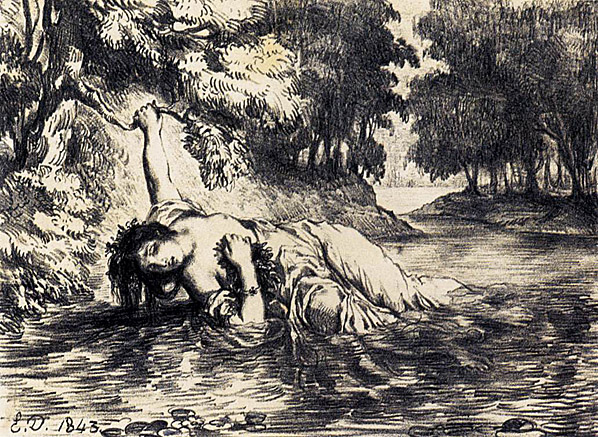


In The Entry of the Crusaders into Constantinople, like in The Massacre of Chios, there is a meditation on the misfortunes of war, in both the conquerors on their trembling steeds tower over prostrate women.

A Monologue from the Play by Lord Byron
DOGE: You see me here,
As one of you hath said, an old, unarmed,
Defenceless man; and yesterday you saw me
Presiding in the hall of ducal state,
Apparent Sovereign of our hundred isles,
Robed in official purple, dealing out
The edicts of a power which is not mine,
Nor yours, but of our masters-the patricians.
Why I was there you know, or think you know;
Why I am here, he who hath been most wronged,
He who among you hath been most insulted,
Outraged and trodden on, until he doubt
If he be worm or no, may answer for me,
Asking of his own heart what brought him here?
You know my recent story, all men know it,
And judge of it far differently from those
Who sate in judgement to heap scorn on scorn.
But spare me the recital-it is here,
Here at my heart the outrage-but my words,
Already spent in unavailing plaints,
Would only show my feebleness the more,
And I come here to strengthen even the strong,
And urge them on to deeds, and not to war
With woman's weapons; but I need not urge you.
Our private wrongs have sprung from public vices,
In this-I cannot call it commonwealth,
Nor kingdom, which hath neither prince nor people,
But all the sins of the old Spartan state
Without its virtues-temperance and valour.
The Lords of Lacedæmon were true soldiers,
But ours are Sybarites, while we are Helots,
Of whom I am the lowest, most enslaved;
Although dressed out to head a pageant, as
The Greeks of yore made drunk their slaves to form
A pastime for their children. You are met
To overthrow this Monster of a state,
This mockery of a Government, this spectre,
Which must be exorcised with blood,-and then
We will renew the times of Truth and Justice,
Condensing in a fair free commonwealth
Not rash equality but equal rights,
Proportioned like the columns to the temple,
Giving and taking strength reciprocal,
And making firm the whole with grace and beauty,
So that no part could be removed without
Infringement of the general symmetry.
In operating this great change, I claim
To be one of you-if you trust in me;
If not, strike home,-my life is compromised,
And I would rather fall by freemen's hands
Than live another day to act the tyrant
As delegate of tyrants: such I am not,
And never have been-read it in our annals;
I can appeal to my past government
In many lands and cities; they can tell you
If I were an oppressor, or a man
Feeling and thinking for my fellow men.
Haply had I been what the Senate sought,
A thing of robes and trinkets, dizened out
To sit in state as for a Sovereign's picture;
A popular scourge, a ready sentence-signer,
A stickler for the Senate and "the Forty,"
A sceptic of all measures which had not
The sanction of "the Ten," a council-fawner,
A tool-a fool-a puppet,-they had ne'er
Fostered the wretch who stung me. What I suffer
Has reached me through my pity for the people;
That many know, and they who know not yet
Will one day learn: meantime I do devote,
Whate'er the issue, my last days of life
My present power such as it is, not that
Of Doge, but of a man who has been great
Before he was degraded to a Doge,
And still has individual means and mind;
I stake my fame (and I had fame)-my breath-
(The least of all, for its last hours are nigh)
My heart-my hope-my soul-upon this cast!
Such as I am, I offer me to you
And to your chiefs; accept me or reject me,
A Prince who fain would be a Citizen
Or nothing, and who has left his throne to be so.

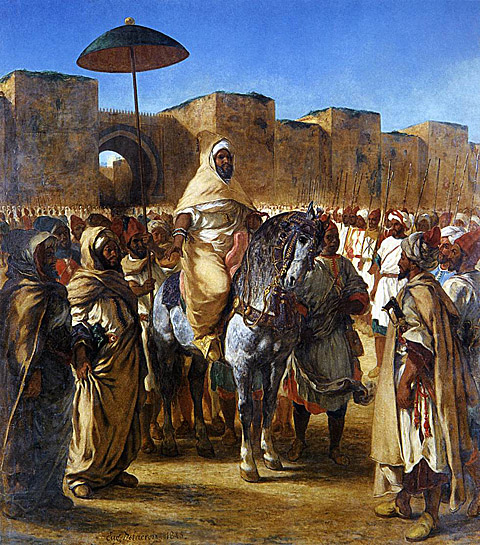
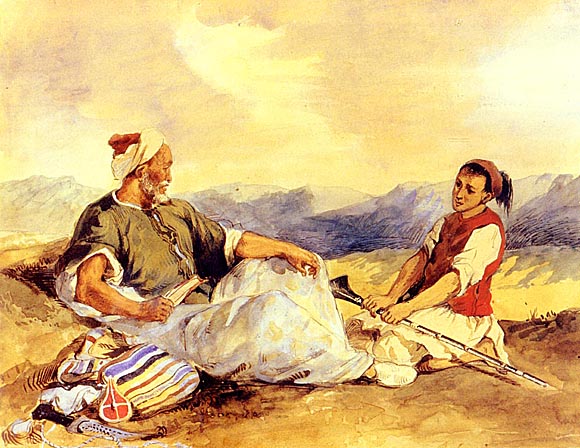
~Senex Magister
France's imperial ambitions in North Africa began with Napoleon's attempted invasion of Egypt in 1798. In 1830, the French occupied Algiers, followed in 1831 by Oran. French settlers arrived in Algeria in 1834 and by 1838 the country had been incorporated into the French state. Tunisian attacks on Algeria led to France establishing a protectorate over Tunisia in 1881. In 1912, France and Spain partitioned Morocco between them.
Between the World Wars, the Destour Party in Tunisia opposed French colonial rule. After a lengthy struggle, France granted self-government in 1955, followed by independence in 1956. The same year, France granted independence to French Morocco, restoring Muhammad V as Sultan.
Algeria's struggle for independence was harder. The French regarded it as a part of metropolitan France. Its large population of French colonists owned most of the productive land, and Moroccans had few rights. In 1954, the FLN (Front de Libération Nationale) began a brutal civil war that was to last for eight years. The French military continued to hold the cities, but could not subdue the FLN guerrillas in the countryside. The conflict was only resolved in 1962, when President General de Gaulle offered the Algerians a referendum: they voted for complete independence from France.

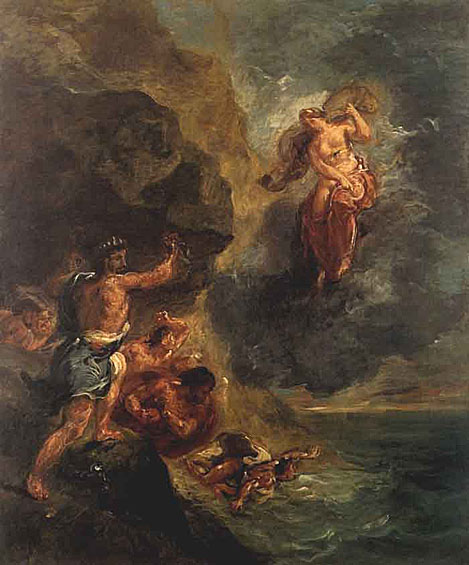
So debating with herself, her heart inflamed, the goddess came to Aeolia, to the country of storms, the place of wild gales. Here in his vast cave, King Aeolus, keeps the writhing winds, and the roaring tempests, under control, curbs them with chains and imprisonment. They moan angrily at the doors, with a mountain's vast murmurs: Aeolus sits, holding his scepter, in his high stronghold, softening their passions, tempering their rage: if not, they'd surely carry off seas and lands and the highest heavens, with them, in rapid flight, and sweep them through the air. But the all-powerful Father, fearing this, hid them in dark caves, and piled a high mountain mass over them and gave them a king, who by fixed agreement, would know how to give the order to tighten or slacken the reins. Juno now offered these words to him, humbly:
'Aeolus, since the Father of gods, and king of men, gave you the power to quell, and raise, the waves with the winds, there is a people I hate sailing the Tyrrhenian Sea, bringing Troy's conquered gods to Italy:
Add power to the winds, and sink their wrecked boats, or drive them apart, and scatter their bodies over the sea. I have fourteen Nymphs of outstanding beauty: of whom I'll name Deiopea, the loveliest in looks, joined in eternal marriage, and yours for ever, so that, for such service to me as yours, she'll spend all her years with you, and make you the father of lovely children.' Aeolus replied: 'Your task, O queen, is to decide what you wish: my duty is to fulfill your orders.
You brought about all this kingdom of mine, the scepter, Jove's favor, you gave me a seat at the feasts of the gods, and you made me lord of the storms and the tempests.'
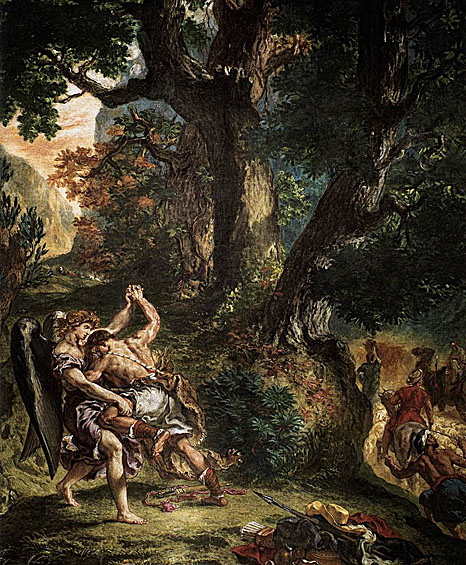
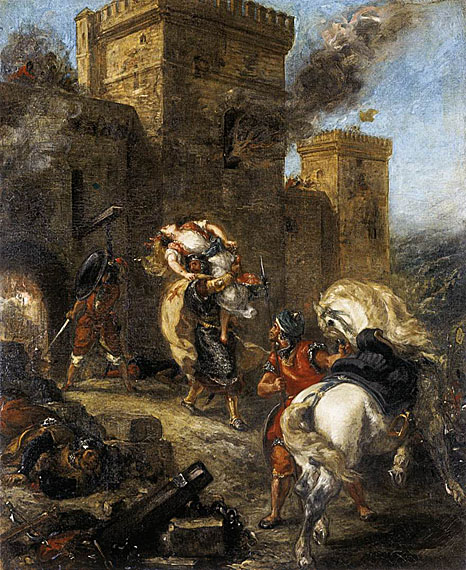
While Delacroix was sometimes very critical of David, he admired and respected him nonetheless. In his extensive journals, Delacroix often criticized David and the school of painters who had learned from David. He said that David was perhaps too formal in the way that he did drawings; he thought that he was "insensitive to the charms of color, as well as too rigid in his interpretation of 'drawing' However, at the same time he respected David in the way that he acknowledged the realistically painted views and the Classical idealistic figures which David painted. In Delacroix's words, "David's work is an extraordinary mixture of realism and the ideal. The great works of Delacroix compared to David have light and color providing a more prominent role. By contrasting his works with David's, it is seen how much more alive they are with imagery, emotion and romantic feeling, rather than the stiff, formal poses of David's work.
Many people, places and factors influenced Delacroix's art. English literature, other artists' work such as David, and contemporary events all had an impact on his work. Making the most out of an opportunity to travel, his one trip to North Africa provided the inspiration for many works there and for years afterwards. He looked at these people as though he was looking at a world of myths and legends, a very romantic notion. He also took contemporary events and painted them in such a way to look beyond the actual event, to make the image into an idealistic version of what happened, or of what he saw. When contrasted with David's classical paintings, Delacroix's appear more vibrant and interestingly arranged. Regardless of what he thought of himself about not being romantic, Delacroix's paintings, with fantastic imagery and beautiful colors, show Romanticism at its finest.
Source: Web Gallery of Art
Source: Art Renewal Center
Return to Pagina Artis
Return to Bruce and Bobbie's Main Page.